Chapter 1: Tracing Changes through a Thousand Years
- Books Name
- CBSE Class 7 Social Science Book
- Publication
- Param Publication
- Course
- CBSE Class 7
- Subject
- Social Science
* Introduction
(i) The changes in the world is a very common phenomenon. History records all the changes that takes place around us.
(ii) This chapter deals with the objective and an overview of the major events which took place in Indian subcontinent during the shift from ancient to medieval period and the various sources and methodology adopted by the historians to interpreted the history.
* Overview
Map I
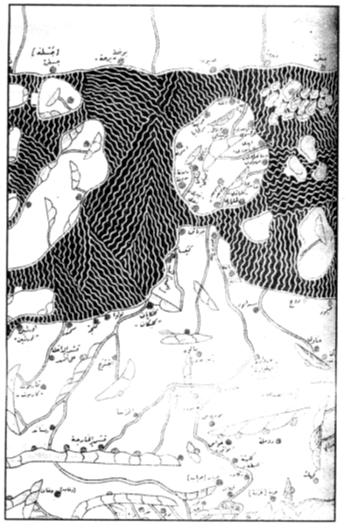
1. Map 1 was made in 1154 CE be the Arab geographer Al-Idrisi. The section reproduced here is a detail of the Indian subcontinent from his larger map of the world
Map II
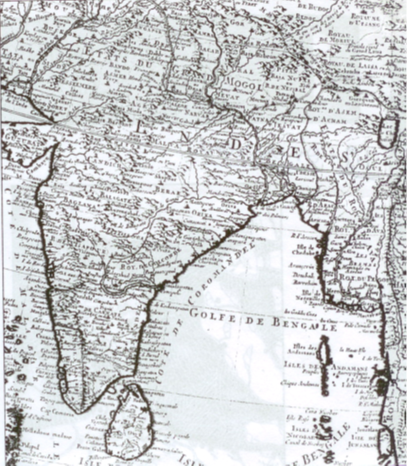
2. Map II was made in the 1720s by a French cartographer. The two maps are quite different even though they are of the same area.
(a) In a Al-Idrisi’s map, south India is where we would except to find north India and Sri Lanka is the island at the top.
(b) Map II was made nearly 600 years after Map 1, during which time information about the subcontinent has changed considerably.
(c) Map II seems more familiar to us and the coastal areas in particular are surprisingly detailed.
(d) Map II was used by European sailors and merchants on their voyages.
3. When historians read documents, maps and texts from the past they have to be sensitive to the different historical backgrounds - the contexts - in which information about the past was produced.
* New and Old Terminologies
1. If the context in which information is produced changes with time, Historical records exists in a variety of languages which have changed considerably over the years.
2. Medieval Persian, for example, is different from modern Persian. The difference is not just with regard to grammar and vocabulary; the meanings of words also change over time.
(a) The term ‘Hindustan’ today we understand it as “India”, the modern nation-state.
(b) Minhaj-i Siraj, a chronicler who wrote in Persian, by Hindustan he meant the areas of Punjab, Haryana and the lands between the Ganga and Yamuna.
3. The fourteenth-century poet Amir Khusrau used the word “Hind” or Hindustan as the idea of a geographical and cultural entity like “India” did exist, the term “Hindustan” did not carry the political and national meanings which we associated with it today.
4. Historians today have to be careful about the terms they use because they meant different things in the past.
5. Simple term like ‘foreigner”. It is used today to mean someone who is not an Indian.
(i) In the medieval period a “foreigner” was any stranger who appeared say in a given village, someone who was not a part of that society or culture.
* Historians and their Sources
Historians use different types of sources to learn about the past depending upon the period of their study and the nature of their investigation.
(i) The sources used by historians for the study are coins, inscription, architecture and textual records for information.
(ii) But there is also considerable discontinuity.
(iii) The number and variety of textual records increased dramatically during this period.
(iv) They slowly displaced other types of available information.
(v) Through this period paper gradually became cheaper and more widely available.
(vi) People used it to write holy texts, chronicles of rulers, letters and teachings of saints, petitions and judicial records, and for registers of accounts and taxes.
(vii) Manuscripts were collected by wealthy people, rulers, monasteries and temples.
(viii) They were placed in libraries and archives.
(ix) These manuscripts and documents provide a lot of detailed information of historians but they are also difficult to use, because the scribes introduced small changes in it.
(x) As a result historians have to read different manuscript versions of the same text to read different manuscript versions of the same text to guess what the author had originally written.
On occasion authors revised their chronicles at different times. The fourteenth-century chronicles Ziauddin Barani wrote his chronicle first in 1356 and another version two years later.
“Glossary”
(i) Cartographer : A person who makes maps.
(ii) Archives : A place where documents and manuscripts are stored.
* New Social and Political Groups
(i) The study of the thousand years between 700 and 1750 is a huge challenge to historians largely because of the scale and variety of developments that occurred over the period.
(ii) At different moments in this period new technologies made their appearance - like the Persian wheel in irrigation, the spinning wheel in weaving, and firearms in combat.
(iii) New foods and beverages arrived in the subcontinent - potatoes, corn, chillies, tea and coffee.
(iv) All these innovations - new technologies and crops - came along with people, who brought other ideas with them as well.
(v) This was also a period of great mobility. Groups of people travelled along distances in search of opportunity.
(vi) One group of people who became important in this period where the Rajputs, a name derived from “Rajputra”, the son of a ruler.
Between the eight and fourteenth centuries the term was applied more generally to a group of warriors who claimed Kshatriya caste status.
(vii) The term included not just rulers and chieftains but also soldiers and commanders who served in the armies of different monarchs all over the subcontinent.
(viii) A chivalric code of conduct - extreme valour and a great sense of loyalty - were the qualities attributed to Rajputs by their poets and bards.
(ix) Other groups of people such as the Marathas, Sikhs, Jats, Ahoms and Kayasthas (a caste of scribes and secretaries) also used the opportunities of the age to become politically important.
(x) Throughout this period there was a gradual clearing of forests and the extensions of agriculture, a change faster and more complete in some areas than in others.
(xi) Changes in their habitat forced many forest-dwellers to migrate. Others started tilling the land and became peasants.
(xii) These new peasant groups gradually began to be influenced by regional markets, chieftains, priests, monasteries and temples.
(xiii) They became part of large complex societies, and were required to pay taxes and offer goods and services to local lords.
(xiv) As a result, significant economic and social differences more productive land, others also kept cattle, and some combined artisanal work with agricultural activity during the lean season.
(xv) As society became more differentiated, people were grouped into jatis or sub-castes and ranked on the basis of their backgrounds and their occupations.
(a) Ranks were not fixed permanently, and varied according to the power, influence and resources controlled by members of the jati. The status of the same jati could vary from area to area.
(b) Jatis framed their own rules and regulations to manage the conduct of their members.
(c) These regulations were enforced by an assembly to elders, described in some areas as the jati panchayat.
(d) But jatis were also required to follow the rules of their villages.
(e) Several villages were governed by a chieftain. Together they were only one small unit of a state.
* Region and Empire
(i) Large states like those of the Cholas, Tughlaqs or Mughals encompassed many regions.
(ii) Sanskrit prashasti praising the Delhi Sultan Ghiyasuddin Balban (1266-1287) explained that he was the ruler of a vast empire that stretched from Bengal (Guada) in the east to Ghazni (Gajjana) in Afghanistan in the west and included all of south India (Dravida).
(iii) People of different regions Gauda, Andhra, Kerala, Karnataka, Maharashtra and Gujarat - apparently fled before his armies.
(iv) Historians regard these as exaggerated claims of conquest.
(v) At the same time, they try to understand why rulers kept claiming to have control over different parts of the subcontinent.
Language and Region
(i) By 700 many regions already possessed distinct geographical dimensions and their own language and cultural characteristics.
(ii) They were also associated with specific ruling dynasties.
(iii) There was considerable conflict between these states.
(iv) Occasionally dynasties like the Cholas, Khaljis, Tughlaqs and Mughals were able to build an empire that was pan-regional-spanning diverse regions.
(v) Not all these empires were equally stable or successful.
(vi) When the Mughal Empire declined in the eighteenth century, it led to the re-emergence of regional states.
* Old and New Religions
(i) People’s belief in the divine was sometimes deeply personal, but more usually it was collective.
(ii) It was during this period that important changes occurred in what we call Hinduism today. These included the worship of new deities, the construction of temples by royalty and the growing importance of Brahmanas, the priests, as dominant groups in society.
(iii) Their knowledge of Sanskrit texts earned the Brahmanas a lot of respect in society. Their dominant position was consolidated by the support of their patrons - new rulers were searching for prestige.
(iv) One of the major developments of this period was the emergence of the idea of bhakti - of a loving, personal deity that devotees could reach without the aid of priests or elaborate rituals.
(v) Merchants are migrants who first brought the teachings of the holy Quran of India in the seventh century. Muslims regard the Quran as their holy book and accept the sovereignty of the one God, Allah, Whose love, mercy and bound embrace all those who believe in him, without regard to social background.
(vi) There were the Shia Muslims who believed that the Prophet Muhammad’s son in law, Ali, was the legislative leader of the Muslim community.
(vii) Sunni Muslims who accepted the authority of the early leaders (Khalifas) of the community, and the succeeding Khalifas.
(viii) There were other important difference between the various schools of law (Hanafi and Shariyat mainly in India) and in theology and mystic traditions.
* Thinking about Time and Historical Periods
Historians do not see time just as a passing of hours days or years - as clock or a calendar.
(i) In the middle of the nineteenth century British historians divided the history of Indian three period “Hindu”, “Muslim” and “British”.
(ii) This division was based on the idea that the religion of rulers was the only important historical change, and that were no other significant developments - in the economy society or culture.
(iii) Such a division also ignored the rich diversity of the subcontinent.
(iv) Few historians follow this periodisation today. Most look to economic and social factors to characterise the major elements of different moments of the past.
(v) The histories you read last year included a wide range of early societies-hunter-gatherers, early empires and kingdoms.
Chapter 10: Eighteenth Century Political Formations
- Books Name
- CBSE Class 7 Social Science Book
- Publication
- Param Publication
- Course
- CBSE Class 7
- Subject
- Social Science
* INTRODUCTION
Aurangzeb’s reign of more than half-a-century ended in March 1707. In that month and year, Aurangzeb died at Ahmednagar in Deccan. With his death, India again entered a period of crisis for the next half a century. Lacking any succession policy, there ensued a war of succession, in which two of Aurangzeb’s sons and three grandsons were killed, before 60 year old Shah Alam took the name of Bahadur Shah, and ascended the throne. Soon the Mughal Empire began to witness rapid decline and disintegration.
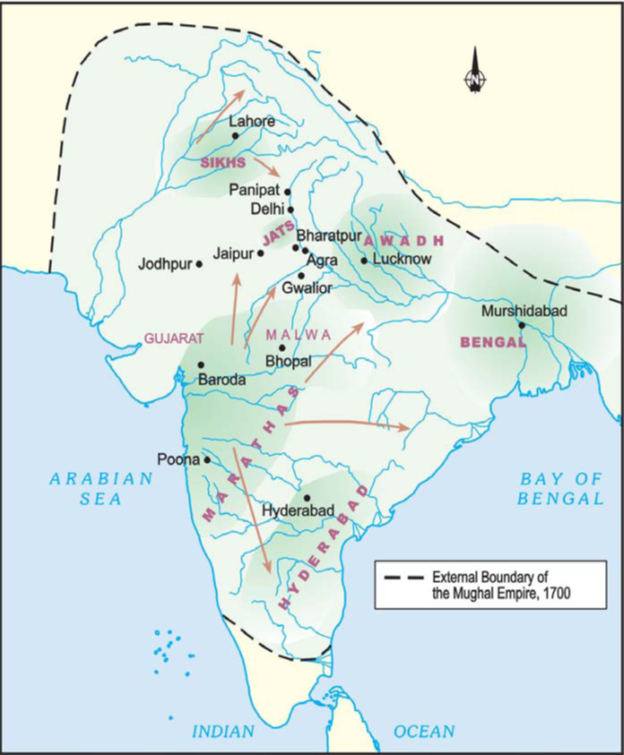
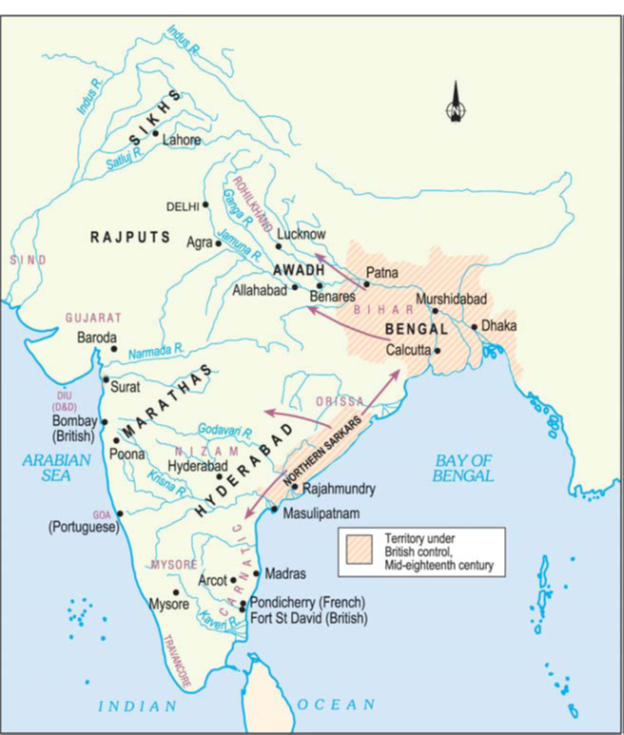
* The Crisis of the Empire and the Later Mughals
- The Mughal Empire reached the height of its success and started facing a variety of crises towards the closing years of the seventeenth century. These were caused by a number of factors. Emperor Aurangzeb had depleted the military and financial resources of his empire by fighting a long war in the Deccan.
- The efficiency of the imperial administration broke down. It became increasingly difficult for the later Mughal emperors to keep a check on their powerful mansabdars.
- Nobles appointed as governors (subadars) often controlled the offices of revenue and military administration (diwani and faujdari) as well. This gave them extraordinary political, economic and military powers over vast regions of the Mughal Empire. As the governors consolidated their control over the provinces, the periodic remission of revenue to the capital declined.
- Peasant and zamindari rebellions in many parts of northern and western India added to these problems. These revolts were sometimes caused by the pressures of mounting taxes, by powerful chieftains to consolidate their own positions.
- In the midst of this economic and political crisis, the ruler of Iran, Nadir Shah, sacked and plundered the city of Delhi in 1739 and took away immense amounts of wealth. This invasion was followed by a series of plundering raids by the Afghan ruler Ahmad Shah Abdali, who invaded north India five times between 1748 and 1761.
- The empire was further weakened by competition amongst different groups of nobles. They were divided into two major groups or factions, the Iranis and Turanis (nobles of Turkish descent).
- The worst possible humiliation came when two Mughal emperors, Farrukh Siyar (1713-1719) and Alamgir II (1754-1759) were assassinated, and two others Ahmad Shah (1748-1754) and Shah Alam II (1759-1816) were blinded by their nobles.
* Emergence of New States
Through the eighteenth century, the Mughal Empire gradually fragmented into a number of independent, regional states. Broadly speaking the states of the eighteenth century can be divided into three overlapping groups:
(1) States that were old Mughal provinces like Awadh, Bengal and Hyderabad. Although extremely powerful and quite independent, the rulers of these states did not break their formalties with the Mughal emperor.
(2) States that had enjoyed considerable independence under the Mughals as watan jagirs. These included several Rajput principalities.
(3) The last group included states under the control of Marathas, Sikhs and others like the Jats. These were of differing sizes and had seized their independence from the Mughals after a long-drawn armed struggle.
* The Old Mughal Provinces
- Amongst the states that were carved out of the old Mughal provinces in the eighteenth century, three stand out very prominently. These were Awadh, Bengal and Hyderabad.
- All three states were founded by members of the high Mughal nobility who had been governors of large provinces - Sa‘adat Khan (Awadh), Murshid Quli Khan (Bengal) and Asaf Jah (Hyderabad).
- All three had occupied high mansabdari positions and enjoyed the trust and confidence of the emperors. Both Asaf Jah and Murshid Quli Khan held a zat rank of 7,000 each, while Sa’adat Khan’s zat was 6,000.
* Hyderabad
- Nizam-ul-Mulk Asaf Jah, the founder of Hyderabad state, was one of the most powerful members at the court of the Mughal Emperor Farrukh Siyar.
- He was entrusted first with the governorship of Awadh, and later given charge of the Deccan, during 1720-22 Asaf Jah already had full control over its political and financial administration.
- Taking advantage of the turmoil in the Deccan and the competition amongst the court nobility, he gathered power in his hands and became the actual ruler of that region.
- Asaf Jah brought skilled soldiers and administrators from northern India who welcomed the new opportunities in the south.
- He appointed mansabdars and granted jagirs. Although he was still a servant of the Mughal emperor, he ruled quite independently without seeking any direction from Delhi or facing any interference. The Mughal emperor merely confirmed the decisions already taken by the Nizam.
- The state of Hyderabad was constantly engaged in a struggle against the Marathas to the west and with independent Telugu warrior chiefs (nayakas) of the plateau. The ambitions of the Nizam to control the rich textile-producing areas of the Coromandel coast in the east were checked by the British who were becoming increasingly powerful in that region.
* Awadh
- Burhan-ul-Mulk Sa‘adat Khan was appointed subadar of Awadh in 1722 and founded a state which was one of the most important to emerge out of the break-up of the Mughal Empire.
- Awadh was a prosperous region, controlling the rich alluvial Ganga plain and the main trade route between north India and Bengal. Burhan-ul-Mulk also held the combined offices of subadari, diwani and faujdari.
- Burhan-ul-Mulk tried to decrease Mughal influence in the Awadh region by reducing the number of office holders (jagirdars) appointed by the Mughals.
- The accounts of jagirdars were checked to prevent cheating and the revenues of all districts were reassessed by officials appointed by the Nawab’s court. He seized a number of Rajput zamindaris and the agriculturally fertile lands of the Afghans of Rohilkhand.
- The state depended on local bankers and mahajans for loans.
- The revenue farmers (ijaradars) agreed to pay the state a fixed sum of money. Local bankers guaranteed the payment of this contracted amount to the state. In turn, the revenue-farmers were given considerable freedom in the assessment and collection of taxes.
- These developments allowed new social groups, like moneylenders and bankers, to influence the management of the state’s revenue system, something which had not occurred in the past.
* Bengal
- Bengal gradually broke away from Mughal control under Murshid Quli Khan who was appointed as the naib, deputy to the governor of the province. Although never a formal subadar, Murshid Quli Khan very quickly seized all the power that went with that office.
- In an effort to reduce Mughal influence in Bengal he transferred all Mughal jagirdars to Orissa and ordered a major reassessment of the revenues of Bengal. Revenue was collected in cash.
- The formation of a regional state in eighteenth century Bengal therefore led to considerable change amongst the zamindars.
- The close connection between the state and bankers - noticeable in Hyderabad and Awadh as well - was evident in Bengal under the rule of Alivardi Khan (r. 1740-1756). During his reign the banking house of Jagat Seth became extremely prosperous.
* Three common features amongst these states.
(a) First, though many of the larger states were established by erstwhile Mughal nobles they were highly suspicious of some of the administrative systems that they had inherited, in particular the jagirdari system.
(b) Second, their method of tax collection differed. Rather than relying upon the officers of the state, all three regimes contracted with revenue-farmers for the collection of revenue. The practice of ijaradari, thoroughly disapproved of by the Mughals, spread all over India in the eighteenth century. Their impact on the countryside differed considerably.
(c) The third common feature in all these regional states was their emerging relationship with rich bankers and merchants. These people lent money to revenue farmers, received land as security and collected taxes from these lands through their own agents. Throughout India the richest merchants and bankers were gaining a stake in the new political order.
* The Watan Jagirs of the Rajputs
- Many Rajput kings, particularly those belonging to Amber and Jodhpur, had served under the Mughals with distinction. In exchange, they were permitted to enjoy considerable autonomy in their watan jagirs.
- Ajit Singh, the ruler of Jodhpur, was also involved in the factional politics at the Mughal court.
- These influential Rajput families claimed the subadari of the rich provinces of Gujarat and Malwa. Raja Ajit Singh of Jodhpur held the governorship of Gujarat and Sawai Raja Jai Singh of Amber was governor of Malwa. These offices were renewed by Emperor Jahandar Shah in 1713. They also tried to extend their territories by seizing portions of imperial territories neighbouring their watans.
- Nagaur was conquered and annexed to the house of Jodhpur, while Amber seized large portions of Bundi.
- Sawai Raja Jai Singh founded his new capital at Jaipur and was given the subadari of Agra in 1722.
- Maratha campaigns into Rajasthan from the 1740s put severe pressure on these principalities and checked their further expansion.
* Seizing Independence
* The Sikhs
- Several battles were fought by Guru Gobind Singh against the Rajput and Mughal rulers, both before and after the institution of the Khalsa in 1699.
- After his death in 1708, the Khalsa rose in revolt against the Mughal authority under Banda Bahadur’s leadership, declared their sovereign rule by striking coins in the name of Guru Nanak and Guru Gobind Singh, and established their own administration between the Sutlej and the Jamuna.
- Banda Bahadur was captured in 1715 and executed in 1716.
- Under a number of able leaders in the eighteenth century, the Sikhs organized themselves into a number of bands called jathas, and later on misls.
- Their combined forces were known as the grand army (dalkhalsa).
- The entire body used to meet at Amritsar at the time of Baisakhi and Diwali to take collective decisions known as resolutions of the Guru (gurmatas).
- A system called rakhi was introduced, offering protection to cultivators on the payment of a tax of 20 per cent of the produce.
- The Khalsa declared their sovereign rule by striking their own coin again in 1765.
- The Sikh territories in the late eighteenth century extended from the Indus to the Jamuna but they were divided under different rulers. One of them, Maharaja Ranjit Singh, reunited these groups and established his capital at Lahore in 1799.
* The Marathas
- Shivaji (1627-1680) carved out a stable kingdom with the support of powerful warrior families (deshmukhs).
- Groups of highly mobile, peasant-pastoralists (kunbis) provided the backbone of the Maratha army.
- After Shivaji’s death, effective power in the Maratha state was wielded by a family of Chitpavan Brahmanas who served Shivaji’s successors as Peshwa (or principal minister).
- Poona became the capital of the Maratha kingdom.
- The Marathas developed a very successful military organisation. Their success lay in bypassing the fortified areas of the Mughals, by raiding cities and by engaging Mughal armies in areas where their supply lines and reinforcements could be easily disturbed.
- Between 1720 and 1761, the Maratha Empire expanded. It gradually chipped away at the authority of the Mughal Empire.
- Malwa and Gujarat were seized from the Mughals by the 1720s.
- By the 1730s, the Maratha king was recognised as the overlord of the entire Deccan peninsula. He possessed the right to levy chauth and sardeshmukhi in the entire region.
- After raiding Delhi in 1737 the frontiers of Maratha domination expanded rapidly: into Rajasthan and the Punjab in the north; into Bengal and Orissa in the east; and into Karnataka and the Tamil and Telugu countries in the south.
- Expansion brought enormous resources, but it came at a price. These military campaigns also made other rulers hostile towards the Marathas. As a result, they were not inclined to support the Marathas during the third battle of Panipat in 1761.
- Alongside endless military campaigns, the Marathas developed an effective administrative system as well.
- Once conquest had been completed and Maratha rule was secure, revenue demands were gradually introduced taking local conditions into account.
- Agriculture was encouraged and trade revived. This allowed Maratha chiefs (sardars) like Sindhia of Gwalior, Gaekwad of Baroda and Bhonsle of Nagpur the resources to raise powerful armies.
- Ujjain expanded under Sindhia’s patronage and Indore under Holkar’s.
- These cities were large and prosperous and functioned as important commercial and cultural centres.
- The silk produced in the Chanderi region now found a new outlet in Poona, the Maratha capital.
- Burhanpur which had earlier participated in the trade between Agra and Surat now expanded its hinterland to include Poona and Nagpur in the south and Lucknow and Allahabad in the east.
* The Jats
- Under their leader, Churaman, they acquired control over territories situated to the west of the city of Delhi, and by the 1680s they had begun dominating the region between the two imperial cities of Delhi and Agra. For a while they became the virtual custodians of the city of Agra.
- The Jats were prosperous agriculturists, and towns like Panipat and Ballabhgarh became important trading centres in the areas dominated by them.
- Under Suraj Mal, the kingdom of Bharatpur emerged as a strong state. When Nadir Shah sacked Delhi in 1739, many of the city’s notables took refuge there. His son Jawahir Shah had 30,000 troops of his own and hired another 20,000 Maratha and 15,000 Sikh troops to fight the Mughals.
- While the Bharatpur fort was built in a fairly traditional style, at Dig the Jats built an elaborate garden palace combining styles seen at Amber and Agra. Its buildings were modelled on architectural forms first associated with royalty under Shah Jahan.
Chapter 9: The Making of Regional Cultures
- Books Name
- CBSE Class 7 Social Science Book
- Publication
- Param Publication
- Course
- CBSE Class 7
- Subject
- Social Science
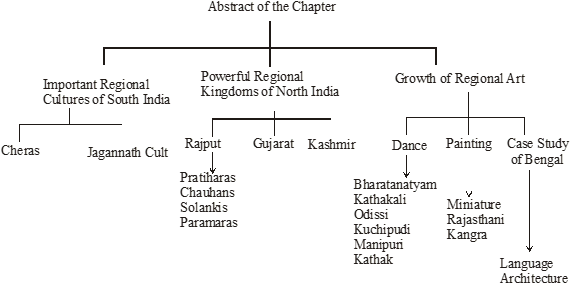
* INTRODUCTION
What we understand as regional cultures today are often the product of complex processes of intermixing of local traditions with ideas from other parts of the subcontinent. As we will see, some traditions appear specific to some regions, others seem to be similar across regions, and yet others derive from older practices in a particular area, but take a new form in other regions.
* Important Regional Cultures of South India
1. The Cheras and the Development of Malayalam
(i) The Chera kingdom of Mahodayapuram was established in the ninth century in the south-western part of the peninsula, part of present-day Kerala.
(ii) It is likely that Malayalam was spoken in this area. The rulers introduced the Malayalam language and script in their inscriptions.
(iii) The temple theatre of Kerala, which is traced to this period, borrowed stories from the Sanskrit epics. Interestingly enough, a fourteenth-century text, the Lilatilakam, dealing with grammar and poetics, was composed in Manipravalam-literally, “diamonds and corals” referring to the two languages, Sanskrit and the regional language.
2. Rulers and Religious Traditions: The Jagannatha Cult
(i) In other regions, regional cultures grew around religious traditions. The best example of this process is the cult of Jagannatha (literally, lord of the world, a name for Vishnu) at Puri, Orissa.
(ii) In the twelfth century, Anantavarman, decided to erect a temple for Purushottama jagannatha at Puri. In 1230, king anangabhima III dedicated his kingdom to the deity and proclaimed himself as the “deputy” of the god.
(iii) All those who conquered Orissa, such as the Mughals, the Marathas and the English East India Company, attempted to gain control over the temple. They felt that this would make their rule acceptable to the local people.
* Powerful Regional Kingdoms of North India
1. The Rajputs and Traditions of Heroism
In the nineteenth century, the region that constitutes most of present-day Rajasthan, was called Rajputana by the British. There were four distinct lineages that could be traced into the Chahamanas or Chauhans, Pratiharas, Solankis and Paramaras.
2. The Prathiharas.
The Gurajara Pratihara dynasty ruled over the area around modern Jodhpur in the 6th century AD. Their kingdom soon extended over Rajasthan, Gujarat, and up to Ujjain. They were engaged in constant wars with the Palas of Bengal and the Rashtrakutas of the Deccan. The Pratiharas ruled up to about 1036.
3. The Chahamanas or Chauhans
The Chauhans ruled in Sambhar near Jaipur in the 7th century AD. Later they conquered Delhi, Part of Punjab and Bundelkhand. Prithviraja III was the last ruler of the Chauhans.
4. The Solankis
The Solankis ruled over Anhilwara in modern Gujarat. Mularaja was their first king. Jayasimha was one of the greatest Solanki kings, who extended his territories into Rajasthan and Gwalior and defeated the Paramaras of Malwa.
5. The Paramaras
The Paramaras ruled in Malwa. Dhara was their capital and Krishnaraja was their first king.
Bhoja was the greatest king, who built a college at Dhara, and the city of Bhojpur near Bhopal.
* Ideals of Rajput Rulers
(i) The Rajputs are often recognised as contributing to the distinctive culture of Rajasthan. These cultural traditions were closely linked with the ideals and aspirations of rulers. From about the eighth century, most of the present-day state of Rajasthan was ruled by various Rajput families.
(ii) These rulers cherished the ideal of the hero who fought valiantly, often choosing death on the battlefield rather than face defeat.
(iii) Stories about Rajput heroes were recorded in poems and songs, which were recited by specially trained minstrels. These preserved the memories of heroes and were expected to inspire others to follow their example. Ordinary people were also attracted by these stories.
* Condition of women in Rajput Society
Sometimes women figure as the “cause” for conflicts, as men fought with one another to either “win” or “protect” women. Women are also depicted as following their heroic husbands in both life and death - there are stories about the practice of sati or the immolation of widows on the funeral pyre of their husbands. So those who followed the heroic ideal often had to pay for it with their lives.
1. Kashmir :
In the 7th century, the Nagarkota Dynasty established itself as the rulers of Kashmir. The most famous king was Lalitaditya Muktapida who conquered part of Punjab and defeated Yashovarman of Kannauj.
2. Gujarat :
Gujarat was conquered by Uluch Khan in 1299 after defeating Raja Karna Vaghela. From that time it was ruled for a long time by Muslim governors appointed by the Delhi Sultans. During the reign of Firoz Tughlaq, the situation in Gujarat became worse and several governors.
* Growth of Regional Art
1. Dance
(A) Beyond Regional Frontiers: The Story of Kathak:
The term Kathak is derived from katha, a word used in Sanskrit and other languages for story.
* Characteristics of Kathak
(i) The kathaks were originally a caste of story-tellers in temples of north India, who embellished their performances with gestures and songs.
(ii) Kathak began evolving into a distinct mode of dance in the fifteenth and sixteenth centuries with the spread of the bhakti movement.
(iii) The legends of Radha-Krishna were enacted in folk plays called rasa lila, which combined folk dance with the basic gestures of the kathak story-tellers.
(iv) It developed in two traditions style. Subsequently. It developed in two traditions or gharanas : one in the courts of Rajasthan (Jaipur) and the other in Lucknow. Under the patronage of Wajid Ali Shah, the last Nawab of Awadh, it grew into a major art form.
(v) Emphasis was laid on intricate and rapid footwork, elaborate costumes, as well as on the enactment of stories.
(B) “Classical” Dances:
What is classical ?
(i) We define something as classical if it deals with a religious theme.
(ii) We consider it classical because it appears to require a great deal of skill acquired through long years of training.
(iii) It is classical because it is performed according to rules that are laid down, and variations are not encouraged.
It is worth remembering that many dance forms that are classified as “folk” also share several of the characteristics considered typical of “classical” forms. So, while the use of the term “Classical” may suggest that these forms are superior, this need not always be literally true.
Other dance forms that are recognised as classical at present are :
- Bharatanatyam (Tamil Nadu)
- Kathakali (Kerala)
- Odissi (Orissa)
- Kuchipudi (Andhra Pradesh)
- Manipuri (Manipur)
2. Painting
(A) Miniature Painting:
Miniatures (as their very name suggests) are small-sized paintings, generally done in water colour on cloth or paper. The earliest miniatures were on palm leaves or wood. Some of the most beautiful of these, found in western India, were used to illustrate Jaina texts. The Mughal emperors Akbar, Jahangir and Shah Jahan patronised highly skilled painters.
Features of Miniature Painting:
(i) Primarily illustrated manuscripts contained historical accounts and poetry.
(ii) These were generally painted in brilliant colours and portrayed court scenes, scenes of battle or hunting, and other aspects of social life.
(iii) They were often exchanged as gifts and were viewed only by an exclusive few-the emperor and his close associates.
(B) Rajasthani Painting;
Features
(i) With the decline of the Mughal Empire, many painters moved out to the courts of the emerging regional states. As a result Mughal artistic taste influenced the regional courts of the Deccan and the Rajput courts of Rajasthan.
(ii) At the same time, they retained and developed their distinctive characteristics.
(iii) Portraits of rulers and court scenes came to be painted, following the Mughal example.
(iv) Besides, themes from mythology and poetry were depicted at centres such as Mewar, Jodhpur, Bundi, Kota and Kishangarh.
(C) Kangra Painting:
Features:
(i) Another region that attracted miniature paintings was the Himalayan foothills around the modern-day state of Himachal Pradesh.
(ii) By the late seventeenth century this region had developed a bold and intense style of miniature painting called Basohli.
(iii) The most popular text to be painted here was Bhanudatta’s Rasamanjari.
(iv) Nadir Shah’s invasion and the conquest of Delhi in 1739 resulted in the migration of Mughal artists to the hills to escape the uncertainties of the plains. Here they found ready patrons which led to the founding of the Kangra school of painting.
(v) The source of inspiration was the Vaishnavite traditions. Soft colours including cool blues and greens, and a lyrical treatment of themes distinguished Kangra painting.
* A Closer Look: Bengal The Growth of a Regional Language and Architecture
While Bengali is now recognised as a language derived from Sanskrit, early Sanskrit texts (mid-first millennium BCE) suggest that the people of Bengal did not speak Sanskritic languages.
(A) How did the new language (Bengali) emerge
(i) From the fourth-third centuries BCE, commercial ties began to develop between Bengal and Magadha (south Bihar), which may have led to the growing influence of Sanskrit.
(ii) During the fourth century the Gupta rulers established political control over north Bengal and began to settle Brahmanas in this area. Thus, the linguistic and cultural influence from the mid-Ganga valley became stronger.
(iii) From the eighth century, Bengal became the centre of a regional kingdom under the Palas. In 1586, when Akbar conquered Bengal, it formed the nucleus of the Bengal suba. While Persian was the language of administration, Bengali developed as a regional language. Although Bengali is derived from Sanskrit, it passed through several stages of evolution.
Bengali literature may be divided into 2 categories

(B) Pirs and Temples
From the sixteenth century, people began to migrate in large numbers from the less fertile western Bengal to the forested and marshy areas of south-eastern Bengal. As they moved eastwards, they cleared forests and brought the land under rice cultivation. Gradually, local communities of fisherfolk and shifting cultivators, often tribals, merged with the new communities of peasants.
This coincided with the establishment of Mughal control over Bengal with their capital in the heart of the eastern delta at Dhaka. Officials and functionaries received land and often set up mosques that served as centres for religious transformation in these areas.
Who were Pirs ?
The early settlers sought some order and assurance in the unstable conditions of the new settlements. These were provided by community leaders, who also functioned as teachers and adjudicators and were sometimes ascribed with supernatural powers. People referred to them with affection and respect as pirs.
This term included saints or Sufis and other religious personalities, daring colonisers and deified soldiers, various Hindu and Buddhist deities and even animistic spirits. The cult of pirs became very popular and their shrines can be found everywhere in Bengal.
Temples:
Bengal also witnessed a temple-building spree from the late fifteenth century, which culminated in the nineteenth century.
Why were temples built in Bengal
(i) Temples and other religious structures were often built by individuals or groups who were becoming powerful-to both demonstrate their power and proclaim their piety.
(ii) Many of the modest brick and terracotta temples in Bengal were built with the support of several “low” social groups, such as the Kolu (oil pressers) and the Kansari (bell metal workers).
(iii) The coming of the European trading companies created new economic opportunities; many families belonging to these social groups availed of these. As their social and economic position improved. The proclaimed their status through the construction of temples.
(iv) When local deities, once worshipped in thatched huts in villages, gained the recognition of the Brahmanas, their images began to be housed in temples, The temples began to copy the double-roofed (dochala) or four-roofed (chauchala) structure of the thatched huts. This led to the evolution of the typical Bengali style in temple architecture.
* Features of Bengali Temples
(i) In the comparatively more complex four-roofed structure, four triangular roofs placed on the four walls move up to converge on a curved line or a point.
(ii) Temples were usually built on a square platform.
(iii) The interior was relatively plain, but the outer walls of many temples were decorated with paintings, ornamental tiles or terracotta tablets.
(iv) In some temples, particularly in Vishnupur in the Bankura district of West Bengal, such decorations reached a high degree of excellence.
(C) Fish as Food
(i) Bengal is a riverine plain which produces plenty of rice and fish. Understandably, these two items figure prominently in the menu of even poor Bengalis. Fishing has always been an important occupation and Bengali literature contains several references to fish. What is more, terracotta plaques on the walls of temples and viharas (Buddhist monasteries) depict scenes of fish being dressed and taken to the market in baskets.
(ii) Brahamanas were not allowed to eat non-vegetarian food, but the popularity of fish in the local diet made the Brahmanical authorities relax this prohibition for the Bengal Brahmanas. The Brihaddharma Purana, a thirteenth-century Sanskrit test from Bengal, permitted the local Brahmanas to eat certain varieties of fish.
Illustration 1
Write any two features of miniature painting ?
Solution
(i) These were generally painted in brilliant colours and portrayed court scenes, scenes of battle or hunting, and other aspects of social life.
(ii) They were often exchanged as gifts and were viewed only by an exclusive few-the emperor and his close associates.
Illustration 2
Why were the Brahmans allowed the eat fish in Bengal ?
Solution
Brahmans were not allowed to eat non-vegetarian food, but the popularity of fish in the local diet made the Brahmanical authorities relax this prohibition for the Bengal Brahmanas.
Chapter 8: Devotional Paths to the Divine
- Books Name
- CBSE Class 7 Social Science Book
- Publication
- Param Publication
- Course
- CBSE Class 7
- Subject
- Social Science
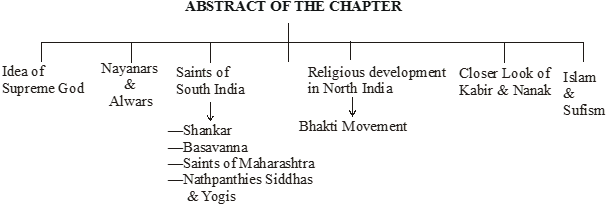
* INTRODUCTION
People perform rituals of worship, or singing bhajans, kirtans or qawwalis, or even repeating the name of God in silence, and noticed that some of them are moved to tears. Such intense devotion or love of God is the legacy of various kinds of bhakti and Sufi movements that have evolved since the eighth century.
* The Idea of Supreme God
As people were brought together through the growth of towns, trade and empires, new ideas began to develop.
(i) The idea that all living things pass through countless cycles of birth and rebirth performing good deeds and bad came to be widely accepted.
(ii) The idea that all human beings are not equal even at birth gained ground during this period. The belief that social privileges came from birth in a “noble” family or a “high” caste was the subject of many learned texts.
(iii) Many people were uneasy with such ideas and turned to the teachings of the Buddha or the Jainas according to which it was possible to overcome social differences and break the cycle of rebirth through personal effort.
(iv) Others felt attracted to the idea of a Supreme God who could deliver humans from such bondage if approached with devotion (or bhakti). This idea, advocated in the Bhagavadgita, grew in popularity in the early centuries of the Common Era.
(v) Shiva, Vishnu and Durga as supreme deities came to be worshipped through elaborate rituals.
(vi) At the same time, gods and goddesses worshipped in different areas came to be identified with Shiva, Vishnu or Durga.
(vii) In the process, local myths and legends became a part of the Puranic stories, and methods of worship recommended in the Puranas were introduced into the local cults. Eventually the Puranas also laid down that it was possible for devotees to receive the grace of God regardless of their caste status.
* A New Kind of Bhakti in South India-nayanaras and Alvars
The seventh to ninth centuries saw the emergence of new religious movements, led by the Nayanars (saints devoted to Shiva) and Alvars (saints devoted to Vishnu) who came from all castes including those considered “untouchable” like the Pulaiyar and the Panars.
(i) They were sharply critical of the Buddhists and Jainas and preached ardent love of Shiva or Vishnu as the path to salvation.
(ii) They drew upon the ideals of love and heroism as found in the Sangam literature (the earliest example of Tamil literature, composed during the early centuries of the Common Era) and blended them with the values of bhakti.
(iii) The Nayanaras and Alvars went from place to place composing exquisite poems in praise of the deities enshrined in the villages they visited, and set them to music.
* Nayanars and Alvars
(i) There were 63 Nayanars, who belonged to different caste backgrounds such as potters, “untouchable” workers, peasants, hunters, soldiers, Brahmanas and chiefs. The best known among them were Appar, Sambandar, Sundarar and Manikkavasagar. There are two sets of compilations of their songs - Tevaram and Tiruvacakam.
(ii) There were 12 Alvars, who came from equally divergent backgrounds, the best known being Periyalvar, his daughter Andal, Tondaradippodi Alvar and Nammalvar. Their songs were compiled in the Divya Prabandham.
(iii) Between the tenth and twelfth centuries the Chola and Pandya kings built elaborate temples around many of the shrines visited by the saint-poets, strengthening the links between the bhakti tradition and temple worship. This was also the time when their poems were compiled. Besides, hagiographies or religious biographies of the Alvars and Nayanars were also composed.
* Philosophy and Bhakti
Shankara, one of the most influential philosophers of India, was born in Kerala in the eighth century.
(i) He was an advocate of Advaita or the doctrine of the oneness of the individual soul and the Supreme God which is the Ultimate Reality.
(ii) He taught that Brahman, the only or Ultimate Reality, was formless and without any attributes.
(iii) He considered the world around us to be an illusion or maya, and preached renunciation of the world and adoption of the path of knowledge to understand the true nature of Brahman and attain salvation.
* Ramanuja, born in Tamil Nadu in the eleventh century, was deeply influenced by the Alvars.
(i) According to him the best means of attaining salvation was through intense devotion to Vishnu. Vishnu in His grace helps the devotee to attain the bliss of union with Him.
(ii) Propounded the doctrine of Vishishtadvaita or qualified oneness in that the soul even when united with the Supreme God remained distinct.
(iii) Ramanuja’s doctrine greatly inspired the new strand of bhakti which develped in north India subsequently.
* Basavanna’s Virashaivism
Virashaiva movement initiated by Basavanna and his companions like Allama Prabhu and Akkamahadevi. The movement began in Karnataka in the mid-twelfth century.
(i) The Virashaivas argued strongly for the equality of all human beings and against Brahmanical ideas about caste and the treatment of women.
(ii) They were also against all forms of ritual and idol worship.
* The Saints of Maharashtra
The most important among them were Janeshwar, Namdev, Eknath and Tukaram as well as women like Sakkubai and the family of Chokhamela, who belonged to the “untouchable” Mahar caste. This regional tradition of bhakti focused on the Vitthala (a form of Vishnu) temple in Pandharpur, as well as on the notion of a personal god residing in the hearts of all people.
(i) These saint-poets rejected all forms of ritualism, outward display of piety and social differences based on birth.
(ii) They even rejected the idea of renunciation and preferred to live with their families, earning their livelihood like any other person, while humbly serving fellow human beings in need.
(iii) A new humanist idea emerged as they insisted that bhakti lay in sharing others’ pain. As the famous Gujarati saint Narsi Mehta said, “They are Vaishnavas who understand the pain of others.”
* Nathpanthis, Siddhas and Yogis
A number of religious groups that emerged during this period criticised the ritual and other aspects of conventional religion and these religion and the social order, using simple, logical arguments. Among them were the Nathpanthis, Siddhacharas and Yogis.
(i) They advocated renunciation of the world. To them the path to salvation lay in meditation on the formless Ultimate Reality and the realisation of oneness with it.
(ii) To achieve this they advocated intense training of the mind and body through practices like yogasanas, breathing exercises and meditation.
(iii) These groups became particularly popular among “low” castes. Their criticism of conventional religion created the ground for devotional religion to become a popular force in northern India.
Illustration 1
Who were the important saints of Maharashtra & what were their beliefs ?
Solution
The most important among them were Janeshwar, Namdev, Eknath and Tukaram
(i) These saint-poets rejected all forms of ritualism, outward display of piety and social differences based on birth.
(ii) They even rejected the idea of renunciation and preferred to live with their families, earning their livelihood like any other person, while humbly serving fellow human beings in need.
* Islam and Sufism
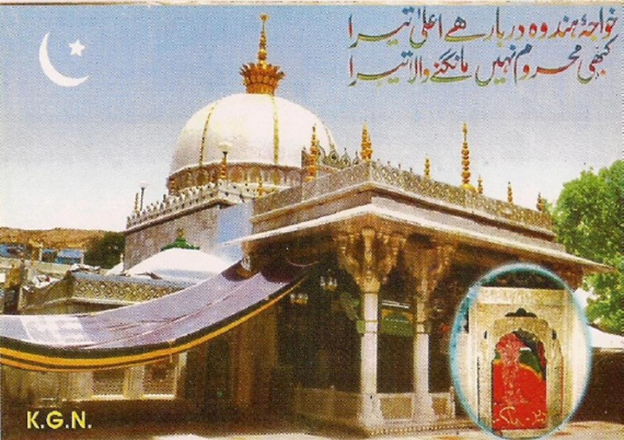
Sufis were Muslim mystics. They rejected outward religiosity and emphasised love and devotion to God and compassion towards all fellow human beings.
Islam propagated strict monotheism or submission to one God. It also rejected idol worship and considerably simplified rituals of worship into collective prayers. At the same time Muslim scholars developed a holy law called Shariat.
(i) The Sufis often rejected the elaborate rituals and codes of behaviour demanded by Muslim religious scholars.
(ii) They sought union with God much as a lover seeks his beloved with a disregard for the world.
(iii) Among the great sufis of Central Asia were Gharyali, Rumi and Sadi.
(iv) Sufis believed that heat can be trained to look at the world in a different way.
(v) Sufis developed elaborate methods of praying using Zikr (chanting of a name or sacred formula), Contemplation, Sama (singing), Rags (dancing), discussion of parables, breath control etc. under the guidance of a master or Pir.
(vi) Thus emerged the silsilas, a genealogy of sufi teachers, each following a slightly different method (tariqa) of instruction and ritual practice.
(vii) A large number of sufis from Central Asia settled in Hindustan from the eleventh century onwards.
(viii) Several major sufi centres developed all over the subcontinent at the time of Delhi Sultanate.
(ix) The Chisti silsila was among the most influential orders.
(x) Some of the prominent saints also known as Pirs were:
(a) Khwaja Muinuddin Chisthi of Ajmer.
(b) Qutbuddin Bakhtiar Kaki of Delhi.
(c) Baba Farid of Punjab.
(d) Khwaja Nizamuddin Auliya of Delhi, and
(e) Bandanawaz Gisudaraz of Gulbarga.
(xi) The Sufi masters held assembly in their Khanqahs or Hospices.
(xii) They discuss spritual matters in Khanqahs and sought the blessing of the saints in solving their worldy problems, simply attended the music and dance session.
(xiii) The tomb or Dargarh of Sufi saint became a place of pilgrimage to which thousands of people of all faiths thronged.
(xiv) Jalaluddin Rumi was a great thirteenth century Sufi poet from Iran who wrote in Persian.
* New Religious Developments in North India
The period after the thirteenth century saw a new wave of the bhakti movement in north India. This was an age when Islam, Brahmanical Hinduism, Sufism, various strands of bhakti, and the Nathpanths, Siddhas and Yogis influenced one another.
(i) Some of them like Kabir and Baba Guru Nanak rejected all orthodox religions. Others like Tulsidas and Surdas accepted existing beliefs and practices but wanted to make these accessible to all. Tulsidas conceived of God in the form of Rama. Tulsidas’s composition, the Ramcharitmanas, written in Awadhi (a language used in eastern Uttar Pradesh), is important both as an expression of his devotion and as a literary work. Surdas was an ardent devotee of Krishna. His compositions, compiled in the Sursagara, Surasavali and Sahitya Lahari, express his devotion.
(ii) Also contemporary was Shankaradeva of Assam (Late fifteenth century) who emphasised devotion to Vishnu, and composed poems and plays in Assamese. He began the practice of setting up namghars or houses of recitation and prayer, a practice that continues to date.
(iii) This tradition also included saints like Dadu Dayal, Ravidas and Mirabai. Mirabai became a disciple of Ravidas, a saint from a caste considered “untouchable”. She was devoted to Krishna and composed innumerable bhajans expressing her intense devotion. Her songs also openly challenged the norms of the “upper” castes and became popular with the masses in Rajasthan and Gujarat.
(iv) Ramananda : Ramananda, a follower of Ramanuja, preached in the second half of the 14th century. He was born in Allahabad but spent most of his life in Benares. He worshipped Lord Rama and Sita. He accepted followers from all castes and religions. Among his close disciples were Ravidas, a cobbler, Sena, a barber and Kabir, a weaver. Ramananda was the first to preach in Hindi.
(v) Chaitanya : Chaitanya was a great religious teacher and a devotee of Lord Krishna. He was born in a learned family in Bengal. At the age of 24, he left his house and his house and travelled all over Deccan, Bihar, Orissa and Bengal. He sang devotional songs and danced in the praise of God. People of all castes and religions gathered around him. Chaitanya composed hymns praising Lord Krishna and popularised musical gatherings called kirtans.
* A unique feature of most of the saints is that
(i) Their words were composed in regional languages and could be sung.
(ii) They became immensely popular and were handed down orally from generation to generation.
(iii) Usually the poorest, most deprived communities and women transmitted these songs, often adding their own experiences.
(iv) Thus the songs as we have them today are as much a creation of the saints as of generations of people who sang them. They have become a part of our living popular culture.
* A Closer Look : Kabir
Kabir, who probably lived in the fifteenth-sixteenth centuries, was one of the most influential saints. He was brought up in a family of Muslim Julahas or weavers settled in or near the city of Benares (Varanasi). We have little reliable information about his life.
* A Closer Look : Baba Guru Nanak
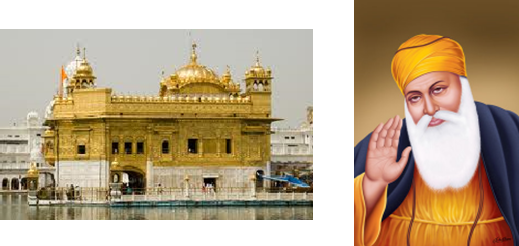
(i) Born at Talwandi (Nankana Sahib in Pakistan), he travelled widely before establishing a centre at Kartarpur (Dera Baba Nanak on the river Ravi) A regular worship that consisted of the singing of his own hymns was established there for his followers.
(ii) Before his death in 1539, Guru Nanak appointed one of his followers as his successor. His name was Lehna but he came to be known as Guru Angad. Guru Angad compiled the compositions of Guru Nanak, to which he added his own in a new script known as Gurmukhi. The three successors of Guru angad also wrote under the name of “Nanak”.
* His Philosophies
His greatest work is the Bijak (the Seedling), an idea of the Fundamental one. This collection of Kabir’s poems demonstrates his own universal spirit of oneness.
(i) The most salient feature of his teachings is the denunciation of polytheism, idolatry and casteism.
(ii) He was a true seeker of God, and did his best to break barriers between the Hindus and Muslims.
(iii) Kabir denounced with equal conviction the narrowness of the Hindus and the formalized, orthodox ways of the Muslims.
(iv) He was influenced both by Sufism and the Bhakti cult and tried to bring them closer. He urged human beings to leave worldly pursuits aside and only aim to reach the Supreme Power.
Illustration 1
How did Sufism spread to India? Where did it originate?
Solution
Sufism came to India along with the Muslim rulers. The word Sufi means ‘one who is pure’. In Greek, a sufi is an enlightened person. Sufism was born in Arabia.
Chapter 7: Tribes, Nomads and Settled Communities
- Books Name
- CBSE Class 7 Social Science Book
- Publication
- Param Publication
- Course
- CBSE Class 7
- Subject
- Social Science
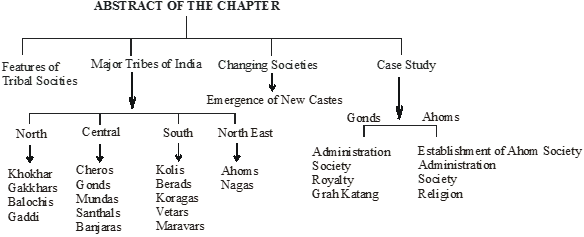
* INTRODUCTION
Many historians and social scientists appear to have accepted the notion that caste divisions in society is a unique.
In large parts of the subcontinent, society was already divided according to the rules of varna. These rules, as prescribed by the Brahmanas, were accepted by the rulers of large kingdoms. The difference between the high and low, and between the rich and poor, increased. Under the Delhi Sultans and the Mughals, this hierarchy between social classes grew further.
* Beyond Big Cities : Tribal Societies
Many societies in the subcontinent did not follow the social rules and rituals prescribed by the Brahmanas. Nor were they divided into numerous unequal classes. Such societies are often called tribes.
* Features of Tribal societies
(i) Members of each tribe were united by kinship bonds. Many tribes obtained their livelihood from agriculture. Others were hunter-gatherers or herders. Most often they combined these activities to make full use of the natural resources of the area in which they lived.
(ii) Some tribes were nomadic and moved from one place to another. A tribal group controlled land and pastures jointly, and divided these amongst households according to its own rules.
(iii) Many large tribes thrived in different parts of the subcontinent. They usually lived in forests, hills, deserts and places difficult to reach.
(iv) They clashed with the more powerful caste-based societies. In various ways, the tribes retained their freedom and preserved their separate culture. But the caste-based and tribal societies also depended on each other for their diverse needs.
* Who were Tribal People ?
(i) According to the Rig Veda and sacred texts dating back to oral traditions of more than 3,000 years ago, there existed four varnas in the Indian society where each group had a function in sustaining the life of society.
(ii) Ancient India mentions the existence of tribes in Mahabharata and in the edicts of King Ashoka.
(iii) These tribals find a mention as forest dwellers during the Mauryan times.
(iv) Historically, they have always existed beyond the mainstream society, guided and governed by their own sets of rules.
(v) Literally meaning ‘indigenous people’ or ‘original inhabitants’.
(vi) Contemporary historians and travellers give very scanty information about tribes. But they preserved rich customs and oral traditions. These were passed down to each new generation.
* Major Tribes In India
* Tribes of North India
(i) North west In Punjab, the Khokhar fourteenth centuries. Later, the Gakkhars became more important. Their chief, Kamal Khan Gakkhar, was made a noble (mansabdar) by Emperor Akbar.
(ii) In Multan and Sind, the Langahs and Arghuns dominated extensive regions before they were subdued by the Mughals.
(iii) The balochis were another large and powerful tribe in the North West. In the Western Himalaya lived the shepherd tribe of Gaddis.
* Tribes of North East India
The distant North-Eastern part of the subcontinent too was entirely dominated by tribes - the Nagas, Ahoms and many others.
* Tribes of Central India
(i) In many areas of present-day Bihar and Jharkhand, Chero chieftiens had emerged by the twelfth century.
(ii) The Mundas and Santhals were among the other important tribes that lived in this region and also in Orissa and Bengal.
(iii) The large tribe of Bhils was spread across Western and Central India.
(iv) The Gonds were found in great numbers across the present-day states of Chhattisgarh, Madhya Pradesh, Maharashtra and Andhra Pradesh.
* Tribes of South India
(i) The Maharashtra highlands and Karnataka were home to Kolis, Berads and numerous others.
(ii) Further South there were large tribal populations of Koragas, Vetars, Maravars and many others.
* How Nomads and Mobile Poeple Lived
(i) Nomadic pastoralists moved over long distances with their animals. They lived on milk and other pastoral products.
(ii) They also exchanged wool, ghee, etc., with settled agriculturists for grain, cloth, utensils and other products.
(iii) They bought and sold these goods as they moved from one place to another, transporting them on their animals.
(iv) The Banjaras were the most important trader nomads.
(v) Their caravan was called tanda.
(vi) Sultan Alauddin Khalji used the Banjaras to transport grain to the city markets.
(vii) Emperor Jahangir wrote in his memoirs that the Banjaras carried grain on their bullocks from different areas and sold it in towns.
(viii) They transported food grain for the Mughal army during military campaigns.
(ix) Many pastoral tribes reared and sold animals, such as cattle and horses, to the prosperous people. Different castes of petty pedlars also travelled from village to village.
(x) They made and sold wares such as ropes, reeds, straw matting and coarse sacks. Sometimes mendicants acted as wandering merchants.
(xi) There were castes of entertainers who performed in different towns and villages for their livelihood.
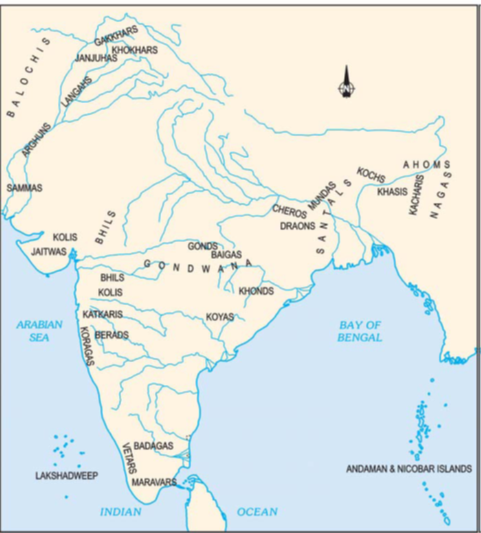
* Changing Society: New Castes and Hierarchies
* Changes in Varna System
1. As the economy and the needs of society grew, people with new skills were required.Smaller castes, or jatis, emerged within varnas. Many tribes and social groups were taken into caste-based society and given the status of jatis.
2. Specialised artisans - smiths, carpenters and masons-were also recognised as separate jatis by the Brahmanas Jatis, rather than varna, became the basis for organising society.
3. Among the Kshatriyas, new Rajput clans became powerful by the eleventh and twelfth centuries. They belonged to different lineages, such as Hunas, Chandelas, Chalukyas and others.
4. The leading tribal families could join the ruling class. A large majority joined the lower jatis of caste society.
5. On the other hand, many dominant tribes of Punjab, Sind and the North-West Frontier had adopted Islam quite early. They continued to reject the caste system. The unequal social order, prescribed by orthodox Hindusim, was not widely accepted in these areas.
* A Closer Look
The Gonds
(i) The Gonds lived in a vast forested region called Gondwana - or “country inhabited by Gonds”.
(ii) They practised shifting cultivation.
(iii) The large Gond tribe was further divided into many smaller clans. Each clan had its own raja or rai.
Administration:
(i) The administrative system of these kingdoms was becoming centralised.
(ii) The kingdom was divided into garhs.
(iii) Each garh was controlled by a particular Gond clan.
(iv) This was further divided into units of 84 villages called chaurasi.
(v) The chaurasi was subdivided into barhots which were made up of 12 villages each.
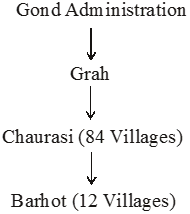
* Society and Royalty
(i) Brahmanas received land grants from the Gond rajas and became more influential.
(ii) The Gond chiefs now wished to be recognised as Rajputs.
(iii) So, Aman Das, the Gond raj of Garha Katanga, assumed the title of Sangram Shah. His son, Dalpat, Married princess Durgawati, the daughter of Salbahan, the Chandel Rajput raja of Mahoba.
(iv) Dalpat, however, died early.
(v) Rani Durgawati was very capable, and started ruling on behalf of her five-year-old son, Bir Narain. Under her, the kingdom became ever more extensive. In 1565, the Mughal forces under Asaf Khan attacked Garha Katanga. A strong resistance was put up by Rani Durgawati.
(vi) She was defeated and preferred to die rather than surrender. Her son, too, died fighting soon after.
* Garha Katanga: Rich State:
(i) Garha Katanga was a rich state.
(ii) It earned much wealth by trapping and exporting wild elephants to other kingdoms.
(iii) When the Mughals defeated the Gonds, they captured a huge booty of precious coins and elephants.
(iv) They annexed part of the kingdom and granted the rest to Chandra Shah, an uncle of Bir Narain.
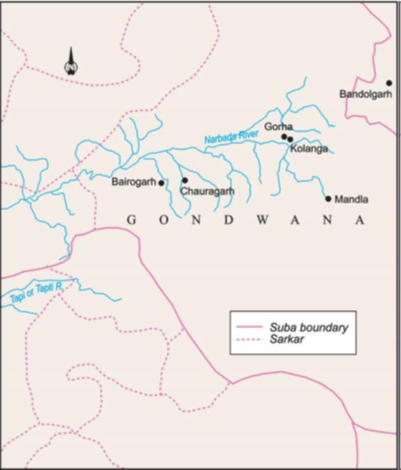
* The Ahoms
Establishment of Ahom State
(i) The Ahoms migrated to the Brahmaputra valley from present-day Myanmar in the thirteenth century. They created a new state by suppressing the older political system of the bhuiyans (landlords).
(ii) During the sixteenth century, they annexed the kingdoms of the Chhutiyas (1523) and of Koch-Hajo (1581) and subjugated many other tribes.
(iii) In 1662, the Mughals under Mir Jumla attacked the Ahom kingdom.
(iv) Despite their brave defence, the Ahoms were defeated.
(v) But direct Mughal control over the region could not last long.
Administration
(i) The Ahom state depended upon forced labour. Those forced to work for the state were called paiks.
(ii) A census of the population was taken.
(iii) Each village had to send a number of paiks by rotation.
(iv) People from heavily populated areas were shifted to less populated places.
(v) Ahom clans were thus broken up.
(vi) By the first half of the seventeenth century the administration became quite centralised.
(vii) Almost all adult males served in the army during war.
(viii) At other times, they were engaged in building dams, irrigation systems and other public works.
(ix) The Ahoms also introduced new methods of rice cultivation.
Society
(i) Ahom society was divided into clans or khels.
(ii) There were very few castes of artisans, so artisans in the Ahom areas came from the adjoining kingdoms.
(iii) A khel often controlled several villages.
(iv) The peasant was given land by his village community.
(v) Even the king could not take it away without the community’s consent.
Religion
(i) Originally, the Ahoms worshipped their own tribal gods.
(ii) During the first half of the seventeenth century.
(iii) However, the influence of Brahmanas increased. Temples and Brahmanas were granted land by the king. In the reign of Sib Singh (1714-1744), Hinduism became the predominant religion.
(iv) But the Ahom kings did not completely give up their traditional beliefs adopting Hinduism.
(v) Ahom society was very sophisticated.
(vi) Poets and scholars were given land grants.
(vii) Theatre was encouraged.
(viii) Important works of Sanskrit were translated into the local language.
(ix) Historical works, known as buranjis, were written-first in the Ahom language and then in Assamese.
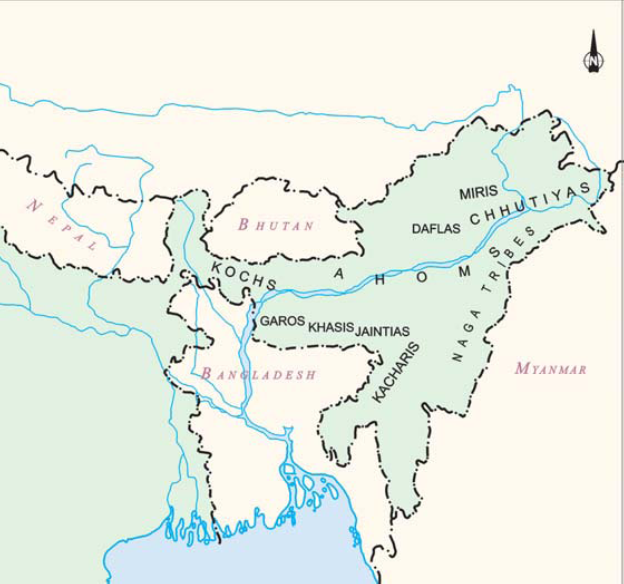
Illustration 1: Which area is the home to the Ahoms?
Solution:
The Ahoms ruled parts of present-day Assam for nearly 600 years, from 1228 to 1826. Historical documents do not call the kingdom “Ahom”. They call it “Asam” (or Assam), and the subjects of this kingdom “Assamese or Asmiya”.
Illustration 2: What did Jahangir write about Banjaras in his memoirs ?
Solution:
Jahangir wrote that Banjaras carried grain on their bullocks from different area and sold it in towns. They transported food grain for the Mughal army during military campaigns.
Chapter 6: Towns, Traders and Craftspersons
- Books Name
- CBSE Class 7 Social Science Book
- Publication
- Param Publication
- Course
- CBSE Class 7
- Subject
- Social Science
Abstract of the Chapter
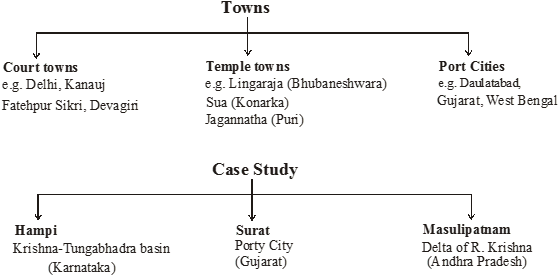
* Introduction
(i) Throughout history, cities, towns and urban areas have served as centres of culture and civilization, facilitating the evolution of knowledge, writing, fine arts, industry and commerce.
(ii) These urban centres play a primary role in the transformation and growth of the economy, in the division of labour, in social, cultural, political evolution, and in opening up to the modern world.
(iii) Towns and cities are the engines for sustainable development and can be part of the world economy.
(iv) In this chapter, we shall study a variety of urban centres such as court towns, pilgrimage centres, ports and trading towns that emerged and developed in the Medieval Period.
* COURT TOWNS OR CAPITAL TOWNS
The court towns are capital cities and the official seat of government in a political entity, such as a state, nation or kingdom.
During this period, a number of Medieval Indian cities emerged.
(i) They were Delhi, Ajmer, Kannauj, Dhera, Mahoba, Chillin, Tripuri under the Rajput Dynasties;
(ii) Kanchi, Badami and Ellora under the Pallava rulers of South India;
(iii) Lahore, Agra, Fatehpur Sikri under the Mughals.
(iv) While Udaipur was the capital of the Rajput kingdom of Mewar, ruled by Ranas of the Sisodia clan,
(v) Fatehpur Sikri served as the political capital of the Mughal Empire under Akbar’s reign from 1571 until 1585. when it was abandoned due to acute scarcity of water.
* PILGRIMAGE CENTRES
(i) In the Medieval times, many places emerged as the pilgrimage centres.
(ii) People believed that visiting these pilgrimage centres washed away all sins.
(iii) There were different pilgrimage centres for Hindus and Muslims.
(iv) The Hindus had four important religious sites - Kedarnath, Gangotri, Yamunotri, Rishikesh. These four places together comprise the Chardham. It is believed that travelling to these places leads to ‘moksha or release from the cycle of rebirths.
(v) Vrindavan is still an important pilgrimage centre for many Hindus.
(vi) Muslims went on Hajj.
(vii) This tradition still continues among this community throughout the world.
(viii) The Hajj is the pilgrimage to Mecca.
(ix) Every Muslim is obliged to undertake a Hajj at least once in his lifetime.
* PORTS AND PORT TOWNS
(i) A port is a place where ships load and unload their goods.
(ii) They are usually situated near the sea or ocean. In the Medieval Period, trade and commerce flourished well with the development of various seaports.
(iii) The beginning of foreign trade led to the development of market places not only in towns but also villages.
(iv) The production of handicrafts increased in order to keep up with the demand for them in foreign countries.
(v) The places with ports helped develop foreign trade.
(vi) The ports themselves grew into thriving towns and cities.
(vii) They became meeting points of foreigners and Indians.
(viii) On the western coast of India—Cambay, Sopara, Broach.
(ix) SURAT, DWARKA, COCHIN, GOA, KAWLAM had become very important seaports because of their trade practices with African, South-West Asian and European countries.
(x) On the East coast were the towns of Tamralipti and Vishakhapatnam through which India maintained commercial relations with South-Eastern countries.
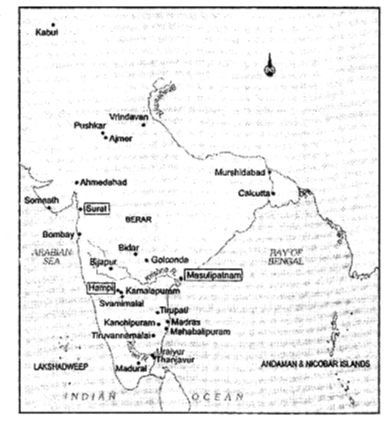
* FLOURISHING OF SEA-TRADE PRACTICES
(i) India was famous for its textiles which formed one of the chief items of export. Duarte Barbosa, a Portuguese official in Cochin in the early 16th century, described Gujarat as a leading cotton trade centre.
(ii) Patola, which is a kind of silk dyed in natural colours, was highly popular in South-East Asia.
(iii) It was in great demand among the wealthy classes in Malaysia, Indonesia and Philippines.
(iv) Ibn Batuta mentions the production of silks in Bengal.
(v) Sirbund, a type of cloth used for tying turbans, was manufactured in Bengal.
(vi) It was highly popular in Europe.
(vii) In South India, Malabar, Golconda, Shaliat and Pulicat were also important textile centres.
(viii) Golconda was famous for Kalamkaris that were exported through the port city of Masulipatnam.
(ix) Other equally precious Indian items were hardwood furniture, carpets, ornamental work in cut stones, ivory, tortoise shells.
(x) Diamonds and pearls were exported from the Deccan.
(xi) Indian spices were also greatly appreciated by the Mughals as well as Europeans,
(xii) Indian arts and crafts were patronised by Indian rulers.
(xiii) India also imported goods from foreign countries.
(xiv) The chief articles that were imported were: horses from Kabul and Arabia, dry fruits and precious stones, glasswares from Europe, high grade textiles like satin from West Asia.
(xv) Raw silk and porcelain from China were also in great demand in Indian markets.
* FLOURISHING OF DOMESTIC TRADE
(i) We get a superb idea about the enormity of the domestic trade in Medieval India from the accounts of foreign travellers.
(ii) Ibn Batutah had described Delhi as a major trade centre.
(iii) The most superior quality rice and sugar found in Kannauj, wheat from Punjab and betel leaves from Dhar found their way to many parts of India due to excellent roadways.
(iv) During the two hundred years of Mughal rule, the urbanisation of India received a further impetus.
(v) The Mughal era witnessed the establishment of a stable centre and a uniform provincial government.
(vi) The prime urban centres during the Mughal era were Agra, Delhi, Lahore, Multan, Thatta and Srinagar in the North.
(vii) The important cities in the West included Ahmedabad, Bombay (then known as Khambat), Surat, Ujjain and Patan (in Gujarat).
(viii) The flourishing trade centres in the Eastern part of the country were Dacca, Hoogli, Patna, Chitgaon and MURSHIDABAD.
(ix) Hampi—the capital of Vijaynagar empire, Masulipatnam on the Bay of Bengal and Surat in Gujarat were the three flourishing trading towns during the medieval times.
* CASE STUDY—HAMPI
(i) Hampi, the 14th century capital city of the Vijaynagar empire, lies in the Deccan in the state of Karnataka.
(ii) Hampi is situated 74 kms from the city of Bellary and 13 kms from Hospet in Karnataka.
(iii) The ruins of Vijaynagar empire in and around the village of Hampi are spread over an area of more than 26 sq. kms.
(iv) This is one of the most fascinating historical sites in southern India.
(v) The area of Hampi is protected by the tempestuous river Tungabhadra in the north and by rocky granite stones on other three sides.
(vi) The monolithic sculptures and monuments along the temples are attractive because of their excellent workmanship.
(vii) The architecture found at Hampi reflects the Hindu culture and splendour of the Vijaynagar empire.
(viii) The rugged landscape adds to the historic ambience of this site.
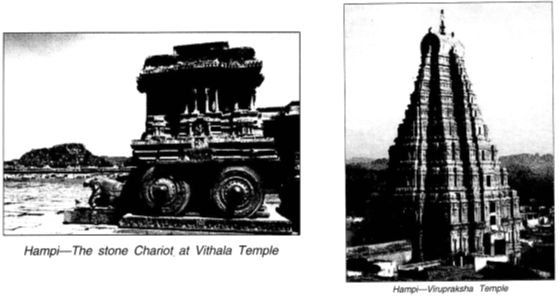
(ix) Places of interest in Hampi are the Virupraksha Temple with its 50 metre high gopuram, Hemakunta Hill with ruins of Jain temples and a monolithic sculpture of Narasimha, Vithala Temple, Sule Bazaar, Achutaraya Temple, purandaradasa mandapa, royal centre that has the Lotus Mahal, the Queen’s Bath, etc.
(x) The Vithala Temple, the most splendid monument of Hampi, is situated on the southern bank of the Tungabhadra river.
(xi) It is known for its extensive sculptured work, ornate pillars and the carvings that decorate them.
(xii) This temple was built during the rule of King Devaraya II.
(xiii) The stone chariot in this temple is very famous.
(xiv) The stone wheels shaped in the form of a lotus are capable of revolving.
(xv) The Virupaksha or the Pampapathi temple is the main centre of pilgrimage at Hampi.
(xvi) This temple is in ruins but people still worship Lord Shiva here.
(xvii) It is situated in picturesque surroundings on the southern bank of the Tungabhadra River to the north of Hemkunta hill.
(xviii) The temple was renovated by Krishnadeva Raya in 1510.
(xix) The temple has several mandapas and murals.
(xx) The eastern gateway is a marvel of engineering skill.
(xxi) The hall has finely carved columns of animals and the ceiling is painted with scenes from mythology.
(xxii) The Karnataka government organises the Vijaynagar Festival in December every year where every effort is made to recreate the grandeur of an era bygone.
* CASE STUDY—MASULIPATNAM
(i) Masulipatnam , also known as Machilipatnam, is a city on the southeastern or Coromandel Coast of India situated on one of the mouths of the river Krishna on the Bay of Bengal.
(ii) Masulipatnam is the administrative centre of Krishna District in the state of Andhra Pradesh.
(iii) It was a 17th century port for French, British and Dutch trade.
(iv) The place derived its name from the construction of a gateway to the town decorated with eyes of fish.
(v) It was a flourishing sea-port during the Satvahana rule.
(vi) It was re-established in the 14th century by Arab traders who found their way from the Red Sea to Southern India.
(vii) Masulipatnam is also one of the earliest known British settlements in the subcontinent of India, its importance being due to the fact that it was the port of Golconda.
(viii) It was the British East Indian Company’s first trading post on the Coromandel Coast. An agency was established there in 1611.
(ix) This port-city is also famous for its Kalamkari textiles and printings created by using vegetable dyes.
(x) During the 17th century the western traders were attracted by this art which brought fabulous wealth to India.
(xi) The long, serene beaches of Masulipatnam attract many tourists every year.
(xii) During an annual Hindu festival— the Mahapoornima, thousands of pilgrims take a dip in the sea.
(xiii) The Pandurangaswami Temple dedicated to Lord Shiva is a great attraction for the Hindu community, while the Masulipatnam Church attracts the Christians.
(xiv) Vijayawada, which is 65 km from Masulipatnam, connects the city by road and rail with the rest of the country.
* CASE STUDY—SURAT
(i) Surat is a port city in the Indian state of Gujarat.
(ii) It is situated on the left bank of the Tapti River, 14 miles from its mouth.
(iii) Surat was the Mughal Empire’s most important port city, and is where the British gained their first foothold along the western coast of India.
(iv) The modern city of Surat was probably established in the 15th century.
(v) In 1514, the Portuguese traveller Duarte Barbosa acclaimed it as a major seaport.
(vi) The British are also believed to have entered India through Surat.
(vii) Surat eclipsed Cambay as the major port of Western India, as Cambay’s harbour had begun to silt up.
(viii) During the reigns of Mughal emperors Akbar, Jahangir and Shah Jahan, it became famous as a major trade centre of India.
(ix) Till the 16th century, the Portugese were the undoubted masters of the sea trade through Surat.
(x) But in 1612, the British destroyed Portugese naval supremacy and made the city the seat of a Presidency under the British East India Company.
(xi) Surat is now the heart of India’s thriving diamond-polishing industry. Furthermore, Surat is an industrial hub for the production of synthetic fibres and man-made fabrics.
(xii) So vital is the textile industry in Surat that the city has been called the ‘Manchester of the East’ since the British times.
* TRADERS IN MEDIEVAL TIMES
(i) Different communities dominated trade in various parts of the country.
(ii) Multani and Punjabi merchants handled the business in the North, while in Gujarat and Rajasthan it was in the hands of the Bhats.
(iii) Foreign traders from Central Asia, known as Khorasanis, engaged in this profession all over India.
(iv) Members of the nobility took an interest in trading activities.
(v) They set up their own manufacturing centres wherein local artisans were employed.
(vi) Internal trade flourished due to an organised system set up by the government.
(vii) The 14th century Sultan Alauddin Khilji, for instance, used to strictly supervise the market places.
(viii) Shopkeepers who were caught violating the rules, were severely punished. Sometimes the trading community used to face unfair treatment from government officials.
(ix) Sometimes they were forced by these officials to sell the products at reduced rates or on credit, thus incurring heavy losses in the process.
* INDIAN CRAFT AND CRAFTSMEN
(i) For centuries, Indian handicrafts have been distinguished for their great aesthetic and functional value.
(ii) Since Ancient Times, the craftsmen conceptualized intricate designs and patterns, which were crafted painfully into the temples and the objects associated with them.
(iii) Apart from the temples, other handicraft items too have gained immense popularity.
(iv) Handicraft items that were patronized by the Mughal royalty show a remarkable refinement of workmanship.
(v) These crafts were often influenced by Persian and indigenous painting traditions.
(vi) The artists prepared the designs on paper which were executed by the craftsmen.
(vii) The designs were assigned to different craftsmen according to their abilities and skill.
(viii) The master craftsman or designer visualized the complete design indicating the details of form, colour distribution and proportion to be realized by various specialists.
(ix) These designs were evident in Indian carpets, brocades, papier mache, stone inlay and so on.
(x) Wooden handicrafts, brass handicrafts, art work on stone, leather accessories, hand-made paper craft work, home furnishings and garment industries flourished greatly in Medieval times.
(xi) Both Indian craftsmen and traders had organised themselves into their own guilds which not only helped them in times of need but also helped them produce different articles of great quality.
(xii) Thus no country could match them in domestic and overseas trade.
* New Towns & Traders
(i) In the sixteenth and seventeenth centuries, European countries were searching for spices and textiles, which had become popular both in Europe and West Asia.
(ii) The English, Dutch and French formed East India Companies in order to expand their commercial activities in the east.
(iii) Initially great Indian traders like Mulla Abdul Ghaiur and Virji Vora who owned a large number of ships competed with them.
(iv) However, the European Companies used their naval power to gain control of the sea trade and forced Indian traders to work as their agents. Ultimately, the English emerged as the most successful commercial and political power in the subcontinent, taking them up.
(v) Indian textile designs became increasingly refined.
(vi) However, this period also saw the decline of the independence of craftspersons.
(vii) They now began to work on a system of advances which meant that they had to weave cloth which was already promised to European agents.
(viii) Weavers no longer had the liberty of selling their own cloth or weaving their own patterns.
(ix) They had to reproduce the designs supplied to them by the Company agents.
(x) The eighteenth century saw the rise of Bombay, Calcutta and Madras, which are nodal dues today.
(xi) Crafts and commerce underwent major changes as merchants and artisans (such as weavers) were moved into the Black Towns established by the European companies within these new cities.
(xii) The “blacks” or native traders and craftspersons were confined here while the “white” rulers occupied the superior residencies of Fort St. George in Madras or Fort St. William in Calcutta.
Illustration 1
Give an account of Industrial activities for which Surat is famous today.
Solution
Surat is known for its diamond industry. Known for its cloth industry, Surat is referred to as the Manchester of the East. Today, Surat is the industrial hub of many large industries like Reliance Petrochemicals, ONGC, etc.
Illustration 2
Explain the importance of Masulipatnam as a trading centre in the Medieval period.
Solution
The foundation of Masulipatnam was laid by the Arab traders in the 14th century. During the Satavahana rule, it was a flourishing sea port. In the 17th century, it was a centre of French, British and Dutch trade.
Illustration 3
Name the travellers who visited India and wrote about India’s thriving trade with the outside world.
Solution
Marco Polo and Ibn Batuta.
Chapter 5: Rulers and Buildings
- Books Name
- CBSE Class 7 Social Science Book
- Publication
- Param Publication
- Course
- CBSE Class 7
- Subject
- Social Science
Abstract of the Chapter

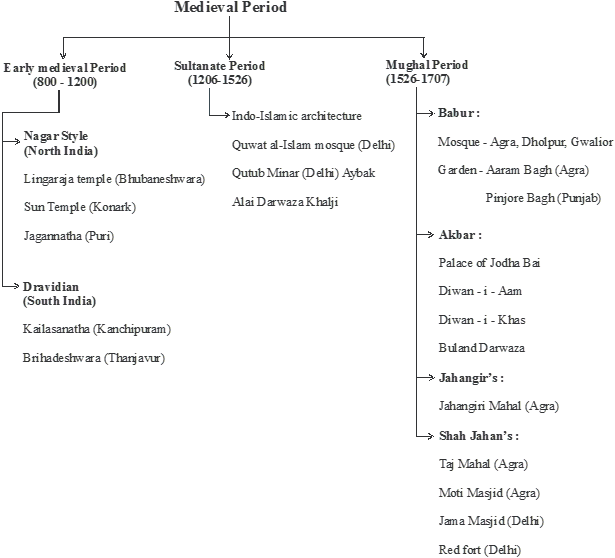
* Introduction
Of the visual arts of Ancient and Medieval India, much architecture and sculpture have survived. The brick buildings of the Harappan Culture were utilitarian, strong and competent—though they had little aesthetic merit. No significant architectural remains between the Harappa Period and that of the Mauryas have been found.
Megasthenes mentions that the palace of Chandragupta Maurya which was large and luxurious was built of carved and gilded wood. Indian buildings in the Mauryan period were not mean or primitive, though they lacked a variety of materials. In the Medieval Period, the adoption of stone as a building medium was due to foreign contacts. The craftsmen learnt their work from Persia and Greece—yet their output had distinctive Indian characteristics.
In this chapter we shall study the various styles adopted in making temples, the differences in the architectural style of the North and the South, the Mughal School of architecture and regional influences.
There is an architectural difference between the temples of the North and those of the South. There emerged two different styles.
* Structure during 8th and 18th Century
(i) Between the eighth and the eighteenth centuries kings and their officers built two kinds of structures: the first were forts, palaces, garden residences and tombs-safe, protected and grand places of rest in this world and the next; the second were structures meant for public acivitiy including temples, mosques, tanks, wells, caravanserais and bazaars.
(ii) Kings were expected to care for their subjects, and by making structures for their use and comfort, rulers hoped to win their praise.
(iii) Construction activity was also carried out by others, including merchants. They built temples, mosques and wells. However, domestic architecture - large mansions (havelis) of merchants - has survived only from the eighteenth century.
* Engineering skills and construction 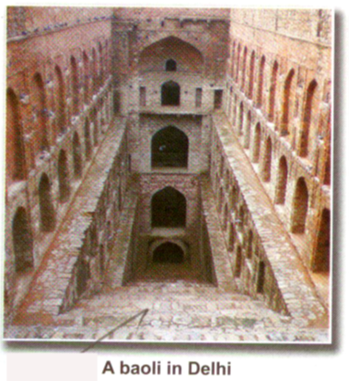
(i) Monuments provide an insight into the technologies used for construction. Take something like a roof for example. We can make this by placing wooden beams or a slab of stone across four walls. But the task becomes difficult if we want to make a large room with an elaborate superstructure. This requires more sophisticated skills.
(ii) Between the seventh and tenth centuries architects started adding more rooms, doors and windows to buildings. Roofs, doors and windows were still made by placing a horizontal beam across two vertical columns, a style of architecture called "trabeate" or "corbelled".
(iii) Between the eighth and thirteenth centuries the trabeate style was used in the construction of temples, mosquies, tombs and in buildings atttached to large stepped-wells (baolis).
(iv) Two technological and stylistic developments and noticeable from the twelfth century. (a) The weight of the superstructure above the doors and windows was sometimes carried by arches. The architectural form was called 'arcuate'.
(v) Limestone cement was increasingly used in construction. This was very high quality cement.
* Temple Construction in the early 11th century
(i) The Kandariya Mahadeva temple dedicated to Shiva was constructed in 999 by the king Dhangadeva of the Chandela dynasty. An ornamented gateway led to an entrance, and the main hall (mahamandapa) where dances were performed. The image of the chief deity was kept in the main shrine (garbhagriha). This was the place for ritual worship where only the king, his immediate family and priests gathered. The Khajuraho complex contained royal temples where commoners were not allowed entry. The temples were decorated with elaborately carved sculptures.
(ii) The Rajarajeshwara temple at Thanjavur had the tallest shikhara amongst temples of its time. Constructing it was not easy because there was no cranes in those days and the 90 tones stone for the top of the shikhara was too heavy to lift manually. So the architects built an inclined path to the top of the temple, placed the boulder on rollers and rolled it all the way to the top. The path started more than 4 km away so that it would not be too steep. This was dismantled after the temple was constructed. But the residents of the area remembered the experience of the construction of the temple for a long time. Even now a village near the temple is called Charupallam, the 'Village of the Incline'.
* Building Temples, Mosques and Tanks
(i) Temples and mosques were beautifully constructed because they were places of worship. They were also meant to demonstrate the power, wealth and devotion of the person.
(ii) Take the examples of the Rajarajeshvara temple. An inscription mentions that it was built by King Rajarajadeva for the worship of his god, Rajarajeshvaram. The names of the ruler and the god are very similar.
(iii) The king took the god's name because it was auspicious and he wanted to appear like a god. Through the rituals of worship in the temple one god (Rajarajadeva) honoured another (Rajarajeshvaram).
(iv) The largest temple were all constructed by kings. The other, lesser deities in the temple were gods and goddesses of the allies and subordinates of the ruler. The temple was a miniature model of the world ruled by the king and his allies. As they worshipped their deities together in the royal temples, it seemed as if they brought the just rule of the gods on earth.
(v) Muslimd Sultans and Padshahs did not claim to be incarnation of god but Persian court chronicles described the Sultan as the 'Shadow of God'. An inscription in the Quwwat al-Islam mosque explained that God chose Alauddin as a king because he had the qualities of Moses and Solmon, the great lawgivers of the past.
(vi) The greatest law giver and architect was God himself. He created the world out of chaos and introduced order and symmetry.
(vii) As each new dynasty came to power, kings wanted to emphasise their moral right to be rulers. Constructing placed of worship provided rulers with the change to proclaim in the age of rapid political change. Rulers also offered patronage to the learned and pious, and tried to transform their capitals and cities into great cultural centres that brought fame to their rule and their realm. One of the buildings, Qutub Minar, built by Qutubuddin Aybak and later completed by Iltutmish is five storeys high. It has been repaired by many rulers like Alauddin Khalji, Muhammad Tughlaq, Firuz Shah Tughlaq and Ibrahim Lodhi.
(viii) It was widely believed that the rule of a just king would be an age of plenty when the heavens would not withhold rain. At the same time, making precious water available by constructing tanks and reservoirs was highly praised. The Persian term 'ab' denotes water. Sultan Iltutmish won universal respect for constructing a large reservoir just outside Delhi-i-kunha. It was called the Hauz-i Sultani or the "King's Reservoir". Rulers often constructed tanks and reservoirs-big and small - for use by ordinary people. Sometimes these tanks and reservoirs were part of a temple, mosque, or a gurudwara. The golden temple or Harmandar Sahib with the holy sarvar (tank) in Amritsar is an example of this.
* Why were temples destroyed?
(i) Kings built temples to demonstrate their devotion to God and their power and wealth. It is not surprising that when they attacked one another’s kingdoms. They of tern targeted these buildings. In the early ninth century when the Pandya king Shrimara Shrivallabha invaled Sri Lanka and defeated the king. Sena I (831-851), the Buddhist monk and chronicler Dhammakitti noted: “he removed ail the valuables. The statue of the Buddha made entirely of gold in the Jewel Palace and the golden images in the various monasteries - all these he seized.” The blow to the pride of the Sinhalese ruler had to be avenged and the next Sinhalese ruler, Sena II, ordered his general to invade Madurai, the capital of the Pandyas.
(ii) The Buddhist chronicler noted that the expedition made a special effort to find and restore the gold statue of the Buddha.
(iii) Similarly In the early eleventh century, when the Chola king Rajendra I built a Shiva temple in his capital he filled it with prized statues seized from defeated rulers. An incomplete list included: a Sun-pedestal from the Chalukyas, a Ganesha statue and several statues of Durga; a Nandi statue from the eastern Chalukyas; an Image of Bhairava (a form of Shiva) and Bhairavi from the Kalingas of Orissa; and a Kali statue from the Palas of Bengal.
(iv) Sultan Mahmud of Ghazni was a contemporary of Rajendra I. During his campaigns in the subcontinent he also attacked the temples of defeated kings and looted their wealth and idols. Sultan Mahmud was not a very important ruler at that time. But by destroying temples - especially the one at Somnath - he tried to win credit as a great hero of Islam. In the political culture of the middle Ages most rulers displayed their political might and military success by attacking and looting the places of worship of defeated rulers.
"Glossary"
1. Superstructure: The part of a building above the ground floor.
2. Ab: The Persian word meaning water.
3. Pietradura: Coloured, hard stones placed in depressions carved into marble or sandstone creating beautiful patterns.
4. Trabeate: It is a style or architecture in which roofs, doors and windows are made by placing a horizontal beam across two vertical columns.
5. Arcuate: A style of architecture in which weight of the superstructure above the doors and windows is sometime carried by arches.
6. Chahar Bagh: Formal gardens, built during Mughal period. They were placed within rectangular walled enclosures and divided into four quarters by artificial channels. Chahar Bagh means four gardens because of their symmetrical division into quarters.
7. Hasht-Bihisht: A central hall surrounded by eight rooms. Also known as 'eight paradises' it was an architectural style of Mughal period.
8. Gothid: It is a style of architecture in which churches are build making use of high pointed arches, use of stained glass, painted with scenes from Bible, flying buttresses, talls spires bell towers. Eg. Church of Notre Dame in Paris.
9. Baolis: Large stepped wells.
10. Diwan-i-khas: The Ceremonial halls of private audience.
11. Pishtaq: Tall gateway.
12. Oibla: The direction faced by Muslim at prayers, which is towards Mecca.
13. Shikara: The top most part of a temple. It is also called as spire.
14. Chihil Sutuns: The forty pillared hall.
"Do you know"
1. Quwwat-al-islam Mosque was the first Turkish mosque constructed by Qutbuddin Aibak in 1197 AD.
2. In 1200 AD Qutbuddin Aibak built Adhai-din-Ra Jhopra, a mosque in Ajmer.
3. Alai Darwaza was the first building built on scientific lines having a true arch during khalji period. Marshal says "Alai Darwaja is the most beautiful diamond of Islamic architecture".
4. Babur laid the foundation of Mughal Empire in India. He was born on 14 February, 1483 at Fargana. His ancestors belonged to Tainure on paternal side and Changez khan on internal side.
5. Babur wrote is autobiography in Turkish language called "Tuzuk-i-Babari".
6. Mughal period is also known as 'Second Classical Age' due to its multifaceted cultural contributions to Indian history.
7. Shahjahanabad was the new capital of Shahjahan, built in 1638, AD near bank of Yamuna river in Delhi.
8. Shahjahan built a fort in his new capital with red sandstones, which became famous as 'Red Fort'.
9. 'Diwan-i-khas' is built in Red Fort. It is exceptionally marvelous in style and beauty. Its ceiling is made of silver and decorated with gold, marble and semi-precious stones. Amir Khusro has rightly said "Agar Firdaus Var Rubi Zami nast, Hami Ast Hami Ast", i.e. If there is any where paradise on earth, is here, it is here.
10. Some famous building build by Shahjahan at Delhi were Jama Masjid, Lal Kila, Diwan-i-am, Diwan-i-khas, Moti Mahal, Rong Mahal and Nahar-i-Bahisht.
Illustration 1
Explain pietra-dura.
Solution
It was the flora inlay work with precious and semiprecious stones.
* Gardens, Tombs and Forts
1. Under the Mughals, architecture became more complex, Babur, Humayun, Akbar, Jahangir and especially Shah Jahan were personally interested in literature, are the architecture. In his autobiography, Babur described his interest in Planning and laying out formal gardens, placed within rectangular walled enclosures and divided into four quarters by artificial channel.
2. These gardens were called Chahar bagh, four gardens, because of their symmetrical division into quarters. Beginning with Akbar, some of the most beautiful chahar baghs were constructed by Jahangir and Shah Jahan in Kashmir, Agra and Delhi.
3. There were several important architectural innovations during Akbar's reign. For inspiration. Akbars' architects turned to the tombs of his Central Asian ancestor, Timur. The central towering dome and the tall gateway (pishtaq) became important aspects of Mughal architecture, first visible in Humayun's tomb. The tomb was placed in the centre of a huge formal chahar bagh and built in the tradition known as "eight paradises" or basht bihisht - a central hall surrounded by eight rooms. The building was constructed with red sandstone edge with white marble.
4. It was during Shah Jahan's reign that the different elements of Mughal architecture were fused together in a grand harmonious synthesis. His reign witnessed a huge amount of construction activity especially in Agra and Delhi. The ceremonial halls of public and private audience (diwan-i-khas) were carefully planned. Placed within a large courtyard, these courts were also described as (chihil sutun of forty-pillared halls.
5. Shah Jahan's audience halls were specially constructed to resemble a mosque. The pedestal on which his throne was placed was frequently described as the qibla, the direction faced by Muslims at prayer, since ever body faced that direction when court was in session. The idea of the king as a representative of God on earth was suggested by these architectural features.
6. The connection between royal justice and the imperial court was emphasised by Shah Jahan in his newly constructed court in the Red Fort at Delhi. Behind the emperor's throne were a series pietra dura inlays that depicted the legendary Geek god Orpheus playing the lute. It was believed that Orpheus' music could calm ferocious beasts until the coexisted together peaceably. The construction of Shah Jahan's audience hall aimed to communicate that the king's justice would treat the high and the low as equals creating a world where all could live together in harmony.
7. In the early years of his reign, Shah Jahan's capital was at Agra, a city where the nobility had constructed their homes on the banks of the river Yamuna. These were set in the midst of formal gardens constructed in the chahar bagh format. The chahar bagh garden also had a variation that histories describes as the "river-front garden". In this dwelling was not located in the middle of the chahar bagh but at its edge, close to the bank of the river.
8. Shah Jahan adapted the river-front garden in the layout of the Taj Mahal, the grandest architectural accomplishment of his reign. Here the white marbles mausoleum was placed on a terrace by the edge of the river and the garden was to its south. Shah Jahan developed this architectural from as a means to control the access that nobles had to the river.
9. In the new city of Shahajahanbad that he constructed in Delhi, the imperial palace commanded the river - front. Only specially favoured nobles-like his eldest son Dara shukoh - were given access to the river. All others had to construct their homes in the city away from the River Yamuna.
* Region and Empire
Sharing of idea across regions
(i) As construction activity increased between the eight and eighteenth centuries there was also considerable sharing of ideas across regions: the traditions of one region were adopted by another. In Vijaynagara, for example, the elephant stables of the rulers were strongly influenced by the style of architecture found in the adjoining Sultanates of Bijapur and Golconda. In Vrindavan, near Mathura, temples were constructed in architectural styles that were very similar to the Mughal palaces in Fatehpur Sikri.
(ii) The creation of large empires that brought different regions under their rule helped in this cross-fertilisation of artistic forms and architectural styles. Mughals rulers were particularly skilled in adapting regional architectural styles in the construction of their own buildings. In Bengal, for example, the local rulers had developed a roof that was designed to resemble a thatched hut.
(iii) The Mughals liked this 'bangla dome' so much that they used it in their architecture. The impact of other regions was also evident. In Akbars' capital Fatehpur Sikri many of the buildings show the influence of the architectural styles of Gujarat and Malwa.
(iv) Even through the authority of the Mughal rulers waned in the eighteenth century, the architectural styles developed under their patronage were constantly used as adapted by other rulers whenever they tried to establish their own kingdoms.
* Churches that touches the skies
From the twelfth century onwards, attempts began in France to build churches that were taller and lighter than earlier buildings. This architectural style, known as Gothic, was distinguished by height pointed arches, the use of stained glass, often painted with scenes drawn from the bible, and flying buttresses. Tall spires and bell towers which were visible from a distance were added to the church.
One of the best-known example of this architectural style is the church of Notre Dame in Paris, which was constructed through several decades in the twelfth and thirteenth centuries.
"GLOSSARY"
Meditation : The practice of thinking deeply in silence.
Interior : The internal part of the building.
Shrine : A place where people come to worship because it is connected with a holy person or event.
Spiritual : Connected with the human spirit, rather than the body.
Secular : Acceptance and tolerance of all religious.
Calligraphy : Beautiful handwriting done with a special pen or brush.
Chapter 4: The Mughal Empire
- Books Name
- CBSE Class 7 Social Science Book
- Publication
- Param Publication
- Course
- CBSE Class 7
- Subject
- Social Science
Abstract of the Chapter
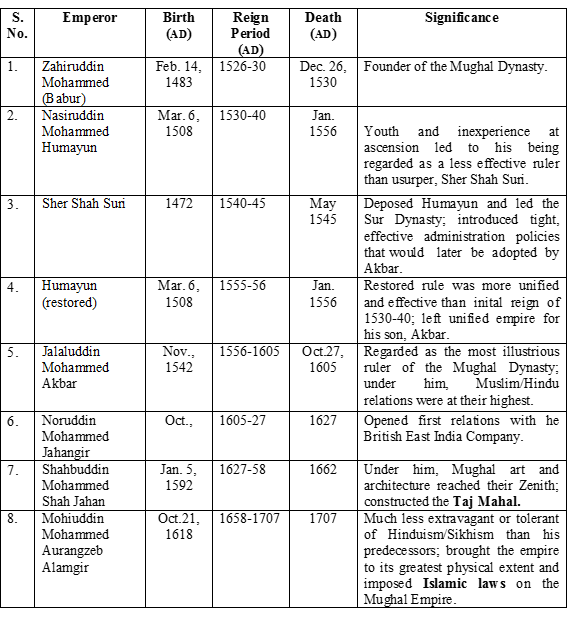
* Introduction 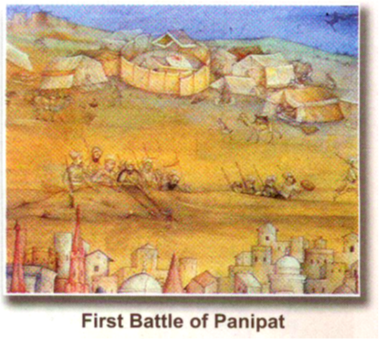
Babur Invaded India in 1526 and established a dynasty called the Mughal Dynasty, which lasted for about 300 years. It was called the Mughal Dynasty because of their Mongol ancestry. On the eve of Babur’s, the political condition of India was very deplorable. The decline of the power of the Sultanate led to the rise of a number of new kingdoms in various parts of the country. The important regional kingdoms were Bengal, Assam, Orissa, Jaunpur, Gujarat, Malwa, Mewar, Kashmir etc. These kingdoms always quarrelled among themselves.
* BABUR (1526-30) 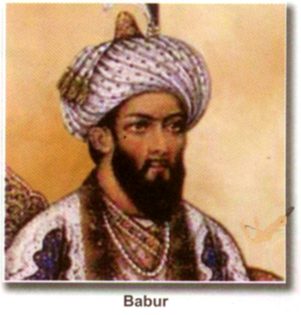
He was a descendent of Timur and Chenghiz Khan. At the age of eleven he became the ruler of Farghana, his birthplace and a small kingdom in Central Asia (now in modern Uzbekistan and Tajikistan).
In 1526, the First Battle of Panipat was fought between Ibrahim Lodi and Babur at Panipat which is about 100 kms from Delhi. Even though Ibrahim Lodi’s army was larger, Babur won the war.
* Due to a number of reasons
1. He had excellent generals and he himself was a very capable military leader.
2. He had a well-trained cavalry (remember the Mongols were skilled horsemen).
3. His artillery used firearms which Ibrahim Lodi’s army was not familiar with.
4. His army though small was well organized and disciplined.
Ibrahim Lodi was killed by Babur who occupied Delhi and Agra and became the emperor of India.
This resulted in Rana Sangha of Mewar and many Afghan nobles turning against him because even though they had invited him to India they had not expected him to stay.
* Battle of Khanwa
A year later Babur fought the Battle of Khanwa against Rana Sangha and defeated him. Later he conquered Gwalior. Dholpur and other places. He became the ruler of Punjab. Delhi, the Ganga plains and Bengal.
* Death of Babur
Unfortunately after four years of rule he died in 1530. He was buried in a beautiful garden in Kabul.
Babur was the founder of the Mughal Empire in India, which for nearly three centuries provided a sense of continuity and unity to the people.
He was an able GENERAL, a POET, a WRITER and a NATURE lover. He loved setting up gardens or baghs.
He was well-versed in both the Turkish and Persian languages.
His autobiography Tuzuk-i-Baburi is beautifully written. It was the first real autobiography in Islamic literature in India.
* HUMAYUN (1530-40, 55)
Babur’s son, Humayun, succeeded him and inherited a large empire. In the four years that Babur had ruled, he had been unable to consolidate his empire and nor was he able to establish an efficient administration. His finances were also low.
Consequently. Humayun had to face a lot of problems in the following shapes: 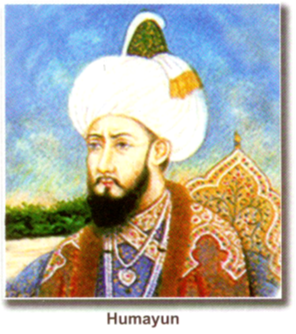
1. The Afghan and Rajput nobles were hostile to the Mughals as they considered them foreigners.
2. He treated his brothers well for he had promised his father to do so on his deathbed. Unfortunately, his brothers were ambitious and disloyal to him and they created problems for him.
3. In western India, Bahadur Shah, the ruler of Gujarat was threatening to invade Delhi.
4. In Eastern India, Sher Shah, an ambitious Afghan ruler became powerful and posed a threat to Delhi.
* AKBAR (1556-1605)
Akbar was 13 years old when he became emperor, His reign can be divided into three periods. 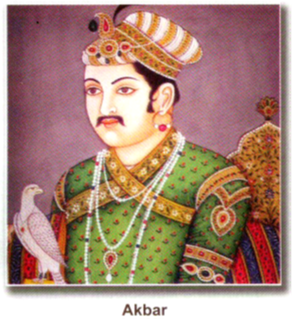
(i) 1556-1570: Akbar became independent of the regent Bairam Khan and other members of his domestic staff. Military campaigns were launched against the Suris and other Afghans, against the neighbouring kingdom of Malwa and Gondwana, and to suppress the revolt of his half-brother Mirza Hakim and the Uzbegs. In 1568 the Sisodiay capital of Chittor was seized and in 1569 Ranthambor.
(ii) 1570-1585: Military campaigns in Gujarat were followed by campaigns in the east in Bihar, Bengal and Orissa. These campaigns were complicated by the 1579-1580 revolt in support of Mirza Hakim.
(iii) 1585-1605: Expansion of Akbar’s empire. Campaigns were launched in the north-west. Qandahar was seized from the Safavids, Kashmir was annexed, as also Kabul, after the death of Mirza Hakim. Campaigns in the Deccan started and Berar, Khandesh and parts of Ahmadnagar were annexed. In the last years of his reign Akbar was distracted by the rebellion of Prince Salim, the future Emperor Jahangir.
* JAHANGIR (1605-1627) 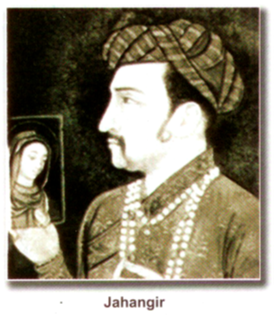
Military campaigns started by Akbar continued the Sisodiay ruler of Mewar, Amar Singh, accepted Mughal service. Less successful campaigns against the Sikhs, the Ahoms and Ahmadnagar followed.
Prince Khurram, the future Emperor Shah Jahan, rebelled in the last years of his reign. The efforts of Nur Jahan, (Jahangir’s wife) to marginalise him were unseccessful.
* SHAH JAHAN (1627-1658) 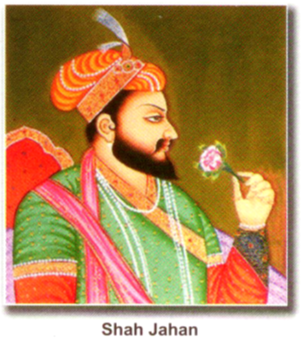
Mughal campaigns continued in the Deccan under Shah Jahan. The Afghan noble Khan Jahan Lodi rebelled and was defeated. In 1632 Ahmadnagar was finally annexed and the Bijapur forces sued for peace. In 1657- 1658, there was conflict over successikon amongst Shah Jahan’s sons. Aurangzeb was victorious and his three brothers, including Dara Shukoh, were killed. Shah Jahan was imprisoned for the rest of his life in Agra.
* AURENGZEB (1658-1707) 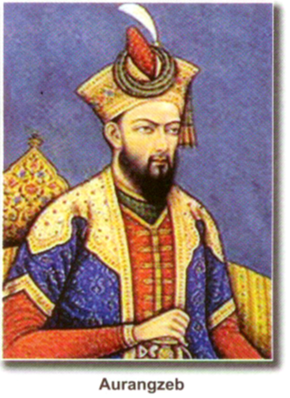
(i) In the north-east, the Ahoms were defeated in 1663, but rebelled again in the 1680s. Campaigns in the north-west against the Yusufzai and the Sikhs were temporarily successful. Mughal intervection in the succession and internal politics of the Rathor Rajputs of Marwar led to their rebellion. Campaigns against the Maratha chieftain Shivaji were initially successful. But Aurangzeb insulted Shivaji who escaped from Agra, declared himself an independent king and resumed his campaigns against the Mughals. Prince Akbar rebelled against Aurangzeb and received support from the Marathas and the Deccan Sultanate. He finally fled to Safavid Iran.
(ii) After Akbar’s rebellion Aurangzeb sent armies against the Deccan Sultanates. Bijapur was annexed in 1685 and Golconda in 1687. From 1698 Aurangzeb personally managed campaigns in the Deccan against the Marathas who started guerrilla warfare. Aurangzeb also has to face the rebellion in north India of the Sikhs, Jats and Satnamis, in the north-east of the Ahoms and in the Deccan of the Marathas. His death was followed by a succession conflict amongst his sons.
Illustration 1
Name three important literary sources that help to know about Mughal history.
Solution
• Tuzuk-i-Baburi
• Humayunama
• Akbarnama
Illustration 2
Discuss the problems faced by Aurangzeb on ascending the throne.
Solution
Aurangzeb’s long rule had to face several political events like :
• Rise of the Marathas under Shivaji
• The peasant rebellions of the Jats of the Agra-Delhi region.
• Conflict with Sikh Guru Teg Bahadur.
• Revolts by the Rajput rulers.
• Portuguese piracy in the Bay of Bengal.
Illustration 3
“Nurjahan played an important role in Mughal history”. Give two examples to justify the statement.
Solution
Her name appeared on farmans along with the imperial signature. She struck coins and also made land grants.
Illustration 4
How did Sher Shah promote trade and commerce?
Solution
Sher Shah levied customs and made it easier and cheaper to transport goods. He built an excellent network of roads such as the Grand Trunk Road. Roads and highways were very safe. Merchants were treated well. He made sarais. All these greatly helped in the growth of trade and commerce.
* CASE STUDY—AKBAR
Akbar, the son of Humayun, was crowned as the king in 1556 when he was just 13 years old. The crowning ceremony took place at Kalanjur in Punjab.
He was more interested in playing and hunting than in ruling his empire. Since Akbar was a minor king Bairam Khan, acted as his regent. He was a loyal friend and an officer of Humayun. Akbar went on to become one of the greatest rulers of North India.
* Sources of Information
During the reign of Akbar, a great book— Akbarnama of which Ain-i-Akbari is a part, was written by Abul Fazl, who was one of the Navaratnas of Akbar’s royal court.
The Akbarnama, which literally means History of Akbar, is a biographical account of Akbar. It is the most comprehensive history of the reign of Akbar.
Ain-i-Akbari was originally the third volume of the Akbarnama. While Akbarnama is technically a history book, Ain-i-Akbari embodies Ains or rules and regulations framed and put into effect for proper administration by Akbar. It is regarded as an administrative manual and is like a modern gazetteer. Abul Fazl also discusses in this book the social conditions, literary activities, the law and philosophy not only of Muslims but also of Hindus, Jains and other communities. There are, in addition, chapters on distinguished travellers, Muslim saints, and sufis.
The Ain-i-Akbari of Abul Fazl is therefore indispensable in the study of the history of India.
* Consolidation and, Expansion of the Empire
Soon after Akbar came to the throne he had to face Hemu, a general of an Afghan prince who was a descendent of Sher Shah. Hemu had occupied Agra and was marching towards Delhi. In 1556, Bairam Khan fought him at Panipat. In the Second Battle of Panipat, Bairam Khan crushed Hemu and ultimately killed him.
After winning this battle Akbar reoccupied Delhi and Agra. Gwalior, Ajmer and Jaunpur also came under Mughal control.
Akbar then set out to conquer more territories :
(i) In 1561 Akbar conquered Malwa and defeated its king,
(ii) Later Gondwana in Central India was annexed.
(iii) Rajput Policy: Akbar’s policy towards the Rajputs was to win them over by marriage alliances and by befriending them. This he did by granting those honours and high positions in the government. He himself married, Jodha Bai, the princess of Amber. The Rajput states of Amber, Ranthambor, Kalinjar, Bikaner and Jaisalmer made alliances with him, except Rana Pratap of Mewar. This led to a battle between the forces of Mewar and the Mughals and even though the fort of Chittor was captured and the troops of Rana Pratap were defeated at the ‘Battle of Haldi Ghati yet Mewar did not surrender to Mughal control. The Rajput policy of Akbar helped him to secure Delhi and Agra; to expand and consolidate his territories and also to enlist the services of the brave Rajput soldiers. The Rajputs were appointed to important posts in the administration.
(iv) Gujarat was conquered in 1578 and the ports of Gujarat meant more revenue for the kingdom through trade.
(v) Later, Bengal was annexed and its seaports encouraged trade with South East Asia. The rich and fertile land of Bengal brought a lot of revenue for the kingdom.
(vi) Akbar conquered Kabul, Kashmir Qandahar and Baluchistan. This increased trade between India, Persia and Central Asia.
* Map Showing Akbars Empire
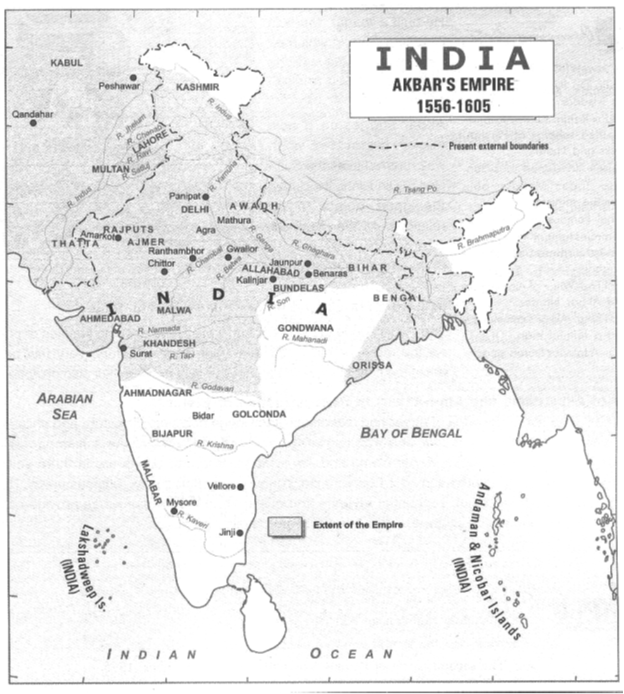
* The Mughal Administration and Key Offices
Central administration. Akbar worked out an efficient system of administration. The emperor was very powerful and supreme. All powers were concentrated in his hands. He interpreted the Islamic law and this led to the decline of the position of the ulemas. The king went on frequent courts of inspection. The system of government was a monarchy.
The emperor ruled with the help of a council of ministers similar to Humayun’s. The ministers were appointed, promoted and removed by him. Some of the different ministers were:
(a) Wazir or the Prime minister. He was also called the Diwan and was the head of the revenue department or two people could separately occupy the offices.
(b) Mir Bakshi was in charge of the military administration.
(c) Qazi was the Chief Justice.
(d) Mir Saman looked after the royal household.
The emperor was accessible to the people and they could meet him with their complaints at the Diwan-i-Aam in the Agra Fort.
Diwan-i-Aam meant the court of the common people and Diwan-i-Khas was the court for nobility and royalty.
His officials and ministers could meet and discuss issues of national importance with him at the Diwan-i-Khas.
* Division of Empire
The empire was divided into provinces or subhas which were fifteen in number.
These were further divided into sarkars, which were further divided into parganas.
Which consisted of many villages. The Subhas were under a subedar who was a provincial Governor and was powerful. He was helped by a number of other officers like the diwan who kept the revenue records, bakshi who looked after the needs of the army and the kotwal who was the officer in charge of the town administration.
(A) Mansabdari System. This system was introduced in Akbar’s army. According to this system:
(a) Every noble or officer was given a mansab or rank. Such a person was called a mansabdar. His rank could vary from 10 to 7000. For example, a panch hazari (5000) mansabdar had to maintain 5000 troops.
(b) A mansabdar had to maintain a fixed number of troops as per his rank and they were to be supplied to the king whenever needed at the time of war.
(c) He was given a handsome amount to take care of his expenses and to maintain the required troops. The amount was generally paid by assigning a jagir, i.e., by granting land and not by paying cash.
(d) Generally a person was appointed at a low rank or mansab and was gradually promoted according to the service he provided.
(e) A mansabdar could be transferred from one place to another to stop him from becoming too powerful. The Mansabdari was also not hereditary.
(B) Revenue System
Revenue formed an important part of the administration. The main sources of income were land revenue and trade. Land revenue was the major source of income for the king. With the help of Raja Todar Mai, Akbar introduced the following measures to generate revenue:
(i) Land was properly measured and assessed.
(ii) Average produce was calculated on the basis of the previous ten years.
(iii) One-third of the revenue was fixed for the state.
(iv) Revenue records were kept up to date.
(v) Needy peasants were given loans by the government.
(vi) In case of drought or floods the land revenue was often cancelled by the king.
* Trade
Trade was another source of income for the king. Gujarat and Bengal had seaports, which encouraged overseas trade.
Goods were traded with Persia, Central Asia, South East Asia and Russia. The main items of export were indigo, textiles, spices and saltpetre.
Trade with Europe also increased at this time and the Portuguese established trade centres in the west coast of India. Through them many Indian products reached the European markets.
Akbar encouraged internal trade through the building of roads and the removal of unnecessary taxes.
* Religious Policy of Akbar
Tolerant Policy. Akbar had a very liberal and tolerant attitude towards people of all religions. He had a secular outlook and believed in the basic unity of all religions. Akbar took various steps, which appealed to the Hindus, who were in the majority among his subjects. These were:
(a) Abolishing of the jizya, a tax paid by non-muslims to a Muslim King.
(b) Hindus, including the Rajput princesses he married, were allowed freedom of worship.
(c) Pilgrimage tax was abolished.
(d) Mansabs were given to deserving Hindus. Todar Mai, Man Singh and Birbal who were Hindus, held important positions in his court.
(e) No discrimination was made on the basis of religion for employment.
* IBADAT KHANA 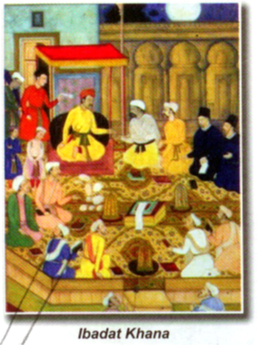
The hall of prayer, i.e., Ibadat Khana, was built by Akbar at Fatehpur Sikri. Here he encouraged preachers and saints from different religions like Hinduism. Parsis, and Christians, etc., to hold discussions with him. Consequently this helped Akbar to know and form an idea of other religions and he realized that all religions had a basic unity. He went on to combine and form a new order emphasizing the basic ideas of all religions.
* DIN-I-ILLAHI
This was a new order, introduced by Akbar and it consisted of the basic ideas of all religions. Din-i-Ilahi encouraged peace, unity and tolerance. Membership into it was not compulsory and its members had to follow certain rules like not eating meat during some months giving up personal property, etc. This new order had no priests, places of worship or sacred books. The sun, light and fire were worshipped.
Din-i-Ilahi died out with Akbar. However, his policy of religious tolerance set an example for many statesmen of the world today.
* Architecture
His new capital was built near Agra at Fatehpur Sikri. It was built of red sand stone. Some fine buildings worth mentioning are Rani Jodhabai’s Palace. Panch Mahal, Rang Mahal, Diwan-i-Khas, etc. The architecture was a blend of Indian, Central Asian and Persian styles. The Buland Darwaza at Fatehpur Sikri was added to commemorate Akbar’s victory over Gujarat. It is the highest gateway in India and one of the biggest in the world.
Why did Akbar choose Fatehpur Sikri as his capital ?
It was chosen by him because it was the birthplace of Salim Chisti, a Sufi saint for whom Akbar had a great respect. The mausoleum over the tomb of Salim Chisti is made of marble and has beautiful mother of pearl and ebony inlay work on it. People from all over visit the tomb, which also has a lot of marble lattice.
Another example of architecture of this period is Humayun’s Tomb, at New Delhi. It is on a raised platform and has many domes and arches. It was enclosed in a garden and has a big gateway. The well-laid garden and the massive gateway seem to be common to most Mughal tombs. SIKANDRA, Akbar’s tomb near Agra, which was started by .Akbar himself, was a huge structure without a dome.
The Mughal type of architecture also influenced temple architecture. An example of this is the Govind Dev Temple at Vrindavan. The Govind Dev Temple is made of red sandstone and shows a distinct mixture of two styles.
* Literature and Music
Though Akbar was illiterate, he was a great patron of learning and encouraged it. He had a sharp memory and was good at learning and often had books read to him. Due to his enthusiasm, he had many talented men at his court. Land grants were given to them to encourage them further.
Akbar’s court was famous for its nine gems or Navratnas. Some of them were TODAR MAL, BIRBAL, TANSEN, ABUL FAZL, Raja Man Singh. Todar Mal helped Akbar in the revenue system of India, Birbal was in own for his wit and humour, Tansen contribution to Hindustani Music is well known. He composed Rag darbari in honour of Akbar. Abul Fazl wrote the famous Akbarnama, a biography of Akbar. Faizi, a Persian scholar translated the Ramayana and part of the Mahabharata into Persian. Raja Man Singh was Akbar’s adviser and a competent general.
Some well-known Hindu poets of this period were Tulsidas, Surdas and Keshavdas. Tulsidas wrote the Ramacharita Manasa, which deals with the life of Lord Rama. Surdas was the blind bard from Agra.
Though Persian was the official language, regional languages were also encouraged.
Paper came to India at this time. This encouraged scholars to write. During Akbar’s time books were written by hand as the printing press was yet to be invented.
It is said that Akbar’s library had a good collection of books even though he himself was illiterate.
* Social Reforms
Akbar made an effort to do away with social evils like sati, child marriage, etc. He restricted the selling of liquor.
Keeping the above points in a view, it can be concluded that under Akbar, architecture, literature, music, and trade progressed. At the same time there was a fusion of Indian, Persian and Central Asian styles. He was truly a national king who not only had a vast empire but was also concerned about the welfare of the people.
Inspite of all these achievements Akbar died an unhappy man in 1605. His two sons Murad and Daniyal died from excessive drinking. Prince Salim revolted against him and was later declared his successor.
GLOSSARY
Regent : A person who rules a country on behalf of the king or queen.
Sarais : Rest houses
Rupia : A new coin introduced by Sher Shah
Jahangir : Conqueror of the world
Khalsa : Literal interpretation means pure
Diwan-i-Aam : Hall of public audience
Diwan-i-Khas : Hall of private audience, where Akbar held private meetings with his officials.
Wazir : Prime Minister or Diwan
Sarkar : District; a suba divided into sarkars
Paragana : An administrative division of sarkar
Kotwal : Officer in charge of law and order
Mansabdar : The holder of a rank (mansab).
Khutba : An Arabic term referring to the Islamic Sermon
Illustration-1
What were the main features of the Mughal Court?
Solution :
Stringent rules were framed to be followed in the courts. The ruler was considered a representative of God on the Earth. Ministers had fixed seats. The rulers took special care to be approachable to the common man.
Illustration-2
“Akbar was known for his secular outlook”. Do you agree? Explain why his religious policy was unique.
Solution :
Akbar’s secular and tolerant religions policies are well known. He invited scholars from all religions and held discussions with them in the Ibadat Khana. He developed the policy of Sulh-i-Kul meaning universal peace. He promulgated Din-i-Ilahi that included the good points of all religions. He believed in all religions and was tolerant towards all religions.
Chapter 3: The Delhi Sultans
- Books Name
- CBSE Class 7 Social Science Book
- Publication
- Param Publication
- Course
- CBSE Class 7
- Subject
- Social Science
* Introduction
The chapter deals with establishment expansion consolidation and downfall of Delhi Sultanate. The policies and programmes of sultans are described with its impacts. The chapter also explains the achievements of sultan of Delhi.
* Historic back ground
Delhi first became the capital of a kingdom under the Tomara Rajputs, who were defeated in the middle of the twelfth century by the Chauhans (also referred to as Chahamanas) of Ajmer. It was under the Tomaras and Chauhans that Delhi became an important commercial centre.
Many rich Jaina merchants lived in the city and constructed several temples. Coins minted here, called Dehliwal, had a wide circulation.
The transformation of Delhi into a capital that controlled vast areas of the subcontinent started with the foundation of the Delhi Sultanate in the beginning of the thirteenth century.
The Delhi Sultans built many cities in the area that we now know as Delhi.
* The rulers of Delhi
(A) RAJPUT DYNASTIES
Tomaras Early twelfth century - 1165
Ananga Pala 1130 -1145
Chauhans 1165 -1192
Prithviraj Chauhan 1175 -1192
(B) EARLY TURKISH RULERS 1206-1290
Qutbuddin Aybak 1206 -1210
Shamsuddin Iltutmish 1210 -1236
Raziyya 1236 -1240
Ghiyasuddin Balban 1266 -1287
(C) KHALJI DYNASTY 1290 - 1320
Jalaluddin Khalji 1290 - 1296
Alauddin Khalji 1296 -1316
(D) TUGHLUQ DYNASTY 1320 - 1414
Ghiyasuddin Tughluq 1320 -1324
Muhammad Tughluq 1324 -1351
Firuz Shah Tughluq 1351 -1388
(E) SAYYID DYNASTY 1414 - 1451
Khizr Khan 1414 -1421
(F) LODI DYNASTY 1451 - 1526
Bahlul Lodi 1451 -1489
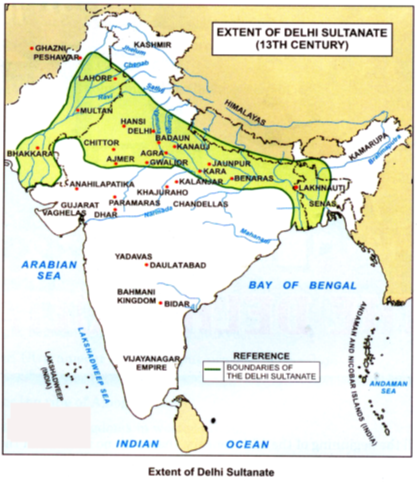
* Finding out about the Delhi Sultans
(i) Although inscriptions, coins and architecture provide a lot of information, especially valuable are “histories”, tarikh (singular) / tawarikh (plural), written in Persian, the language of administration under the Delhi Sultans.
(ii) The authors of tawarikh were learned men: secretaries, administrators, poets and courtiers, who both recounted events and advised rulers on governance, emphasising the importance of just rule.
(iii) Keep the following additional details in mind: (1) the authors of tawarikh lived in cities (mainly Delhi) and hardly ever in villages. (2) They often wrote their histories for Sultans in the hope of rich rewards.
(3) These authors advised rulers on the need to preserve an “ideal” social order based on (i) birthright and (ii) gender distinctions. Their ideas were not shared by everybody.
(iv) In 1236 Sultan Iltutmish’s daughter, Raziyya, became Sultan. The chronicler of the age, Minhaj-i Siraj, recognised that she was more able and qualified than all her brothers. But he was not comfortable at having a queen as ruler. Nor were the nobles happy at her attempts to rule independently. She was removed from the throne in 1240.
(v) What Minhaj-i Siraj thought about Raziyya that the queen’s rule went against the ideal social order created by God, in which women were supposed to be subordinate to men. He therefore asked: “In the register of God’s creation, since her account did not fall under the column of men, how did she gain from all of her excellent qualities?”
On her inscriptions and coins Raziyya mentioned that she was the daughter of Sultan Iltutmish. This was in contrast to the queen Rudramadevi (1262-1289), of the Kakatiya dynasty of Warangal, part of modern Andhra Pradesh. Rudramadevi changed her name on her inscriptions and pretended she was a man. Another queen, Didda, ruled in Kashmir (980-1003). Her title is interesting: it comes from “didi” or “elder sister”, an obviously affectionate term given to a loved ruler by her subjects.
* From garrison town to empire
The expansion of the Delhi Sultanate
(i) In the early thirteenth century the control of the Delhi Sultans rarely went beyond heavily fortified towns occupied by garrisons. The Sultans seldom controlled the hinterland of the cities and were therefore dependent upon trade, tribute or plunder for supplies.
(ii) Controlling garrison towns in distant Bengal and Sindh from Delhi was extremely difficult. Rebellion, war, even bad weather could snap fragile communication routes. The state was also challenged by Mongol invasions from Afghanistan and by governors who rebelled at any sign of the Sultan’s weakness. The Sultanate barely survived these challenges. Its expansion occurred during the reigns of Ghiyasuddin Balban, Alauddin Khalji and Muhammad Tughluq.
(iii) The first set of campaigns along the “internal frontier” of the Sultanate aimed at consolidating the hinterlands of the garrison towns. During these campaigns forests were cleared in the Ganga-Yamuna doab and hunter gatherers and pastoralists expelled from their habitat. These lands were given to peasants and agriculture was encouraged. New fortresses and towns were established to protect trade routes and to promote regional trade.
(iv) The second expansion occurred along the “external frontier” of the Sultanate. Military expeditions into southern India started during the reign of Alauddin Khalji and culminated with Muhammad Tughluq. In their campaigns, Sultanate armies captured elephants, horses and slaves and carried away precious metals.
(v) By the end of Muhammad Tughluq’s reign, 150 years after somewhat humble beginnings, the armies of the Delhi Sultanate had marched across a large part of the subcontinent. They had defeated rival armies and seized cities. The Sultanate collected taxes from the peasantry and dispensed justice in its realm.
* The Masjid
(i) A mosque is called a masjid in Arabic, literally a place where a Muslim prostrates in reverence to Allah. In a “congregational mosque” (masjid-i jami or jama masjid) Muslims read their prayers (namaz) together.
(ii) Members of the congregation choose the most respected, learned male as their leader (imam) for the rituals of prayer. He also delivers the sermon (khutba) during the Friday prayer.
(iii) During prayer, Muslims stand facing Mecca. In India this is to the west. This is called the qibla.
(iv) The Delhi Sultans built several mosques in cities all over the subcontinent. These demonstrated their claims to be protectors of Islam and Muslims. Mosques also helped to create the sense of a community of believers who shared a belief system and a code of conduct. It was necessary to reinforce this idea of a community because Muslims came from a variety of backgrounds.
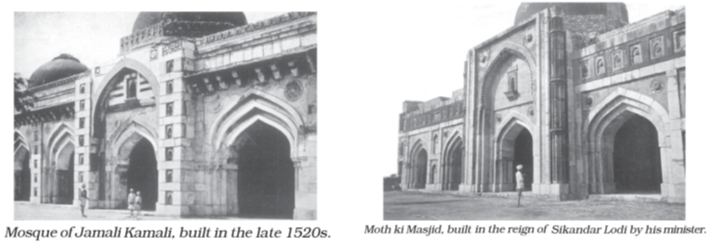
Illustration-1 : Who was the last Hindu ruler before the sultanate rule?
Solution : Prithviraj Chauhan
Illustration-2 : Who established slave dynasty in 1206?
Solution : Qutab-ud-din Aibak
Illustration-3 : Which sultanate rulers policies provoked Hindus to revolt against them ?
Solution : Muhmmad-bin-Tughluq
Illustration-4 : Who sacked Delhi in 1398 ?
Solution : Timur Lung (Lane)
Illustration-5 : Who was the husband of Raziyya Sultan ?
Solution : Malik Altuniya
Illustration-6 : Who killed Raziyya Sultan and her husband ?
Solution : Rebels of her government.
* A closer look: Administration and Consolidation under the Khaljis and Tughluqs
(i) The consolidation of a kingdom as vast as the Delhi Sultanate needed reliable governors and administrators.
(ii) Rather than appointing aristocrats and landed chieftains as governors, the early Delhi Sultans, especially Iltutmish, favoured their special slaves purchased for military service, called bandagan in Persian.
(iii) They (slaves) were carefully trained to man some of the most important political offices in the kingdom. Since they were totally dependent upon their master, the Sultan could trust and rely upon them.
(iv) The Khaljis and Tughluqs continued to use bandagan and also raised people of humble birth, who were often their clients, to high political positions. They were appointed as generals and governors. However, this also introduced an element of political instability.
(v) Slaves and clients were loyal to their masters and patrons, but not to their heirs. New Sultans had their own servants. As a result the accession of a new monarch often saw conflict between the old and the new nobility.
(vi) The patronage of these humble people by the Delhi Sultans also shocked many elites and the authors of Persian tawarikh criticised the Delhi Sultans for appointing the “low and base-born” to high offices.
(vii) Like the earlier Sultans, the Khalji and Tughluq monarchs appointed military commanders as governors of territories of varying sizes. These lands were called iqta and their holder was called iqtadar or muqti.
• The duty of the muqtis was to lead military campaigns and maintain law and order in their iqtas. In exchange for their military services, the muqtis collected the revenues of their assignments as salary.
• They also paid their soldiers from these revenues. Control over muqtis was most effective if their office was not inheritable and if they were assigned iqtas for a short period of time before being shifted.
• These harsh conditions of service were rigorously imposed during the reigns of Alauddin Khalji and Muhammad Tughluq.
• Accountants were appointed by the state to check the amount of revenue collected by the muqtis. Care was taken that the muqti collected only the taxes prescribed by the state and that he kept the required number of soldiers.
(viii) As the Delhi Sultans brought the hinterland of the cities under their control, they forced the landed chieftains — the samanta aristocrats — and rich landlords to accept their authority.
(ix) Under Alauddin Khalji the state brought the assessment and collection of land revenue under its own control. The rights of the local chieftains to levy taxes were cancelled and they were also forced to pay taxes.
(x) The Sultan’s administrators measured the land and kept careful accounts.
(xi) Some of the old chieftains and landlords served the Sultanate as revenue collectors and assessors.
(xii) There were three types of taxes – (1) on cultivation called kharaj and amounting to about 50 per cent of the peasant’s produce, (2) on cattle and (3) on houses.
(xiii) It is important to remember that large parts of the subcontinent remained outside the control of the Delhi Sultans. It was difficult to control distant provinces like Bengal from Delhi and soon after annexing southern India, the entire region became independent. Even in the Gangetic plain there were forested areas that Sultanate forces could not penetrate.
(xiv) Local chieftains established their rule in these regions. Sometimes rulers like Alauddin Khalji and Muhammad Tughluq could force their control in these areas but only for a short duration.
(xv) The Mongols under Genghis Khan invaded Transoxiana in north-east Iran in 1219 and the Delhi Sultanate faced their on slaught soon after. Mongol attacks on the Delhi Sultanate increased during the reign of Alauddin Khalji and in the early years of Muhammad Tughluq’s rule. This forced the two rulers to mobilise a large standing army in Delhi which posed a huge administrative challenge.
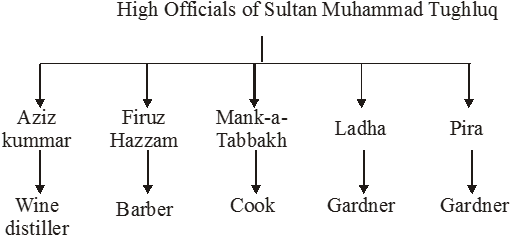
According to Giyasuddin Barni these appointments were sultan's loss of political judgement and incapacity to rule.
* Comparison between Alauddin Khalji and Muhammad Tughluq Alauddin Khalji
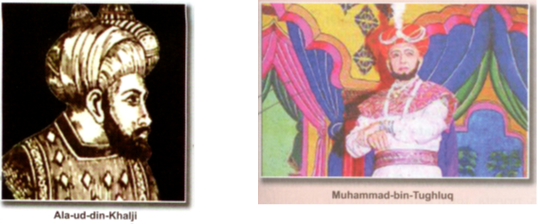
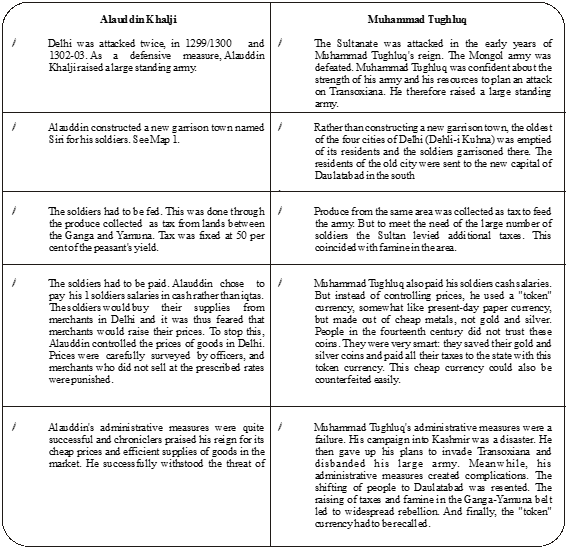
* The Sultanate in the 15th and 16th centuries
(i) After the Tughluqs, the Sayyid and Lodi dynasties ruled from Delhi and Agra until 1526.
(ii) By then, Jaunpur, Bengal, Malwa, Gujarat, Rajasthan and the entire south India had independent rulers who established flourishing states and prosperous capitals.
(iii) This was also the period which saw the emergence of new ruling groups like the Afghans and the Rajputs.
(iv) Some of the states established in this period were small but powerful and extremely well administered.
• Sher Shah Suri (1540-1555) started his career as the manager of a small territory for his uncle in Bihar and eventually challenged and defeated the Mughal emperor Humayun (1530-1540, 1555-1556).
• Sher Shah captured Delhi and established his own dynasty. Although the Suri dynasty ruled for only fifteen years (1540-1555), it introduced an administration that borrowed elements from Alauddin Khalji and made them more efficient.
• Sher Shah’s administration became the model followed by the great emperor Akbar (1556-1605) when he consolidated the Mughal Empire.
Illustration-1 : What was the basis of Sultanate laws?
Solution : Quran & Sharia
Illustration-2: Who encouraged the farmers to grow cash crops amongst the sultanate rules?
Solution: Muhammad bin Tughluq
Illustration-3: Which Tax was imposed on non muslims during sultanate rule?
Solution : Jizya or Head tax.
“Glossary”
1. Birth right: Privileges claimed on account of birth. e.g. people believed that nobles inherited their rights to govern because they were born in certain families.
2. Gender distinctions: Social and biological differences between women and men, usually, these differences are used to argue that men are superior to women.
3. Hinterland: The lands adjacent to a city or part that supply it with goods and services.
4. Garrison town: A fortified settlement with soldiers.
5. Client: Someone who is under the protection of another.
Chapter 2: New Kings and Kingdoms
- Books Name
- CBSE Class 7 Social Science Book
- Publication
- Param Publication
- Course
- CBSE Class 7
- Subject
- Social Science
ABSTRACT
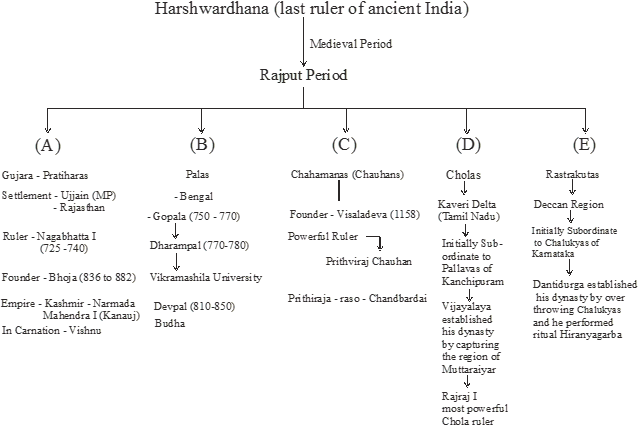
* IntrOduction
The information about Political, Social and Economic life of early medieval period remains imperfect because this period saw the rise of many small kingdom and dynasties. This period saw the rise of many small principalities like Gurjara, Pratiharas, Pallavas, Cholas the Rashtrakutas etc. This chapter is an attempt to provide you the information of this age (700–1200 AD) which is an important part of the history.
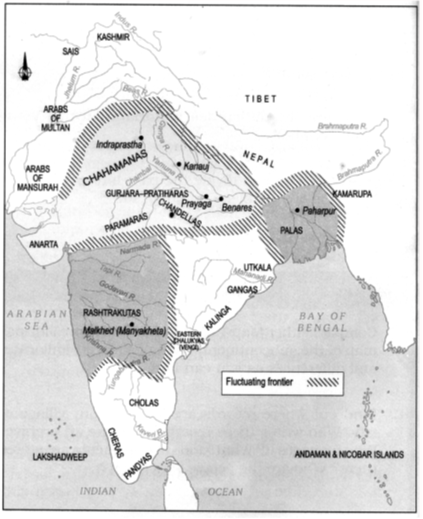
* Emergence of New Dynasties
(i) By the seventh century there were big landlords or warrior chiefs in different regions of the subcontinent.
(ii) Existing kings often acknowledged them as their subordinates or samantas. They were expected to bring gifts for their kings or overlords, be present at their courts and provide them with military support.
(iii) As samantas gained power and wealth, they declared themselves to be maha-samanta, maha-mandaleshvara (the great lord of a “circle” or region) and so on. Sometimes they asserted their independence from their overlords.
(iv) One such instance was that of the Rashtrakutas in the Deccan. Initially they were subordinate to the Chalukyas of Karnataka.
(v) In the mid-eighth century Dantidurga, a Rashtrakuta chief, overthrew his Chalukya overlord and performed a ritual called hiranya-garbha(literally, the golden womb). When this ritual was performed with the help of Brahmanas, it was thought to lead to the “rebirth” of the sacrificer as a Kshatriya, even if he was not one by birth.
(vi) In other cases, men from enterprising families used their military skills to carve out kingdoms. For instance, the Kadamba Mayurasharman and the Gurjara-Pratihara Harichandra were Brahmanas who gave up their traditional professions and took to arms, successfully establishing kingdoms in Karnataka and Rajasthan respectively.
* Administration in the Kingdom
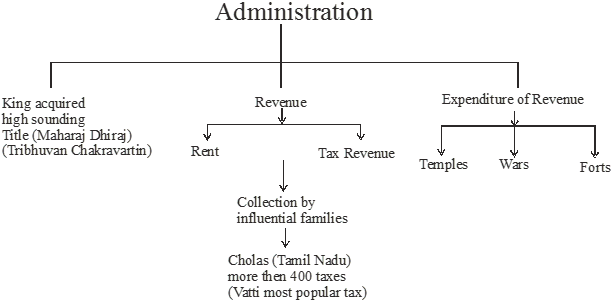
(i) Many of these new kings adopted high-sounding titles such as maharaja-adhiraja (great king, overlord of kings), tribhuvana-chakravartin (lord of the three worlds) and so on.
(ii) However, in spite of such claims, they often shared power with their samantas as well as with associations of peasants, traders and Brahmanas.
(iii) In each of these states, resources were obtained from the producers, that is, peasants, cattle-keepers, artisans, who were often persuaded or compelled to surrender part of what they produced. Sometimes these were claimed as “rent” due to a lord who asserted that he owned the land. Revenue was also collected from traders.
(iv) These resources were used to finance the king’s establishment, as well as for the construction of temples and forts. They were also used to fight wars, which were in turn expected to lead to the acquisition of wealth in the form of plunder, and access to land as well as trade routes.
(v) The functionaries for collecting revenue were generally recruited from influential families, and positions were often hereditary. This was true about the army as well. In many cases, close relatives of the king held these positions.
(vi) Four hundred Taxes
The inscriptions of the Cholas who ruled in Tamil Nadu refer to more than 400 terms for different kinds of taxes. The most frequently mentioned tax is ‘vetti’, taken not in cash but in the form of forced labour, and ‘kadamai’ or land revenue. (There were also taxes on thatching the house, the use of a ladder to climb palm trees, access on succession to family property etc.)
* Prashastis and Land Grants
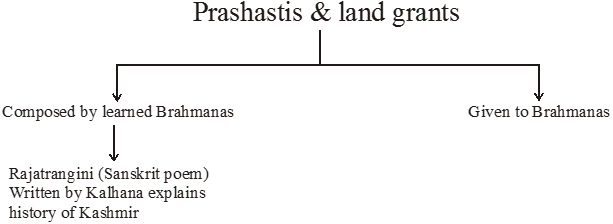
(i) Prashastis contain details that may not be literally true. But they tell us how rulers wanted to depict themselves as valiant, victorious warriors, for example. These were composed by learned Brahmanas, who occasionally helped in the administration
(ii) Kings often rewarded Brahmanas by grants of land. These were recorded on copper plates, which were given
(iii) Unusual for the twelfth century was a long Sanskrit poem containing the history of kings who ruled over Kashmir. It was composed by an author name Kalhana. He used a variety of sources, including inscriptions, documents, eyewitness accounts and earlier histories, to write his account. Unlike the write of prashastis, he was often critical about rulers and their policies.
* Warfare for Wealth(Tripartite Struggle)

(i) You may have noticed that each of these ruling dynasties were based in a specific region. At the same time, they tried to control other areas.
(ii) One particularly prized area was the city of Kanauj in the Ganga valley.
(iii) For centuries, rulers belonging to the Gurjara-Pratihara, Rashtrakuta and Pala dynasties fought for control over Kanauj. Because there were three “parties” in this long-drawn conflict, historians often describe it as the “tripartite struggle”.
(iv) Rulers also tried to demonstrate their power and resources by building large temples. So, when they attacked one another’s kingdoms, they often chose to target temples, which were sometimes extremely rich.
(v) One of the best known of such rulers is Sultan Mahmud of Ghazni, Afghanistan. He ruled from 997 to 1030, and extended control over parts of Central Asia, Iran and the north-western part of the subcontinent. He raided the subcontinent almost every year – his targets were wealthy temples, including that of Somnath, Gujarat.
(vi) Much of the wealth Mahmud carried away was used to create a splendid capital city at Ghazni.
(vii) He was interested in finding out more about the people he conquered, and entrusted a scholar named
Al-Biruni to write an account of the subcontinent. This Arabic work, known as the Kitab-al Hind, remains an important source for historians. He consulted Sanskrit scholars to prepare this account.
* The Chahamanas or Chauhans
Later known as the Chauhans, who ruled over the region around Delhi and Ajmer. They attempted to expand their control to the west and the east, where they were opposed by the Chalukyas of Gujarat and the Gahadavalas of western Uttar Pradesh. The best-known Chahamana ruler was Prithviraja III (1168-1192), who defeated an Afghan ruler named Sultan Muhammad Ghori in 1191, but lost to him the very next year, in 1192.
The CHOLAS
* From Urarya to Thanjavur
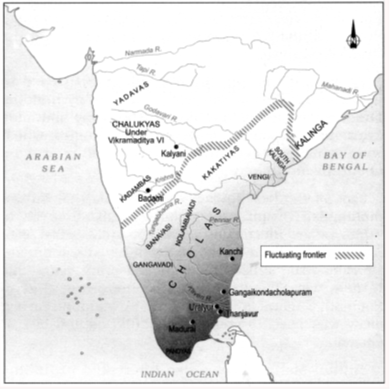
The Cholas of kaveri-delta
(i) A minor chiefly family known as the Mutharaiyar held power in the Kaveri delta. They were subordinate to the Pallava kings of Kanchipuram.
(ii) Vijayalaya, who belonged to the ancient chiefly family of the Cholas from Uraiyur, captured the delta from the Mutharaiyar in the middle of the ninth century. He built the town of Thanjavur and a temple for goddess Nishumbhasudini there.
(iii) The successors of Vijayalaya conquered neighbouring regions and the kingdom grew in size and power. The Pandyan and the Pallava territories to the south and north were made part of this kingdom.
(iv) Rajaraja I, considered the most powerful Chola ruler, became king in 985 and expanded control over most of these areas. He also reorganised the administration of the empire.
(v) Rajaraja’s son Rajendra I continued his policies and even raided the Ganga valley, Sri Lanka and countries of Southeast Asia, developing a navy for these expeditions.
* Art and Architecture of the Rajputs

(i) The big temples of Thanjavur and Gangaikondacholapuram, built by Rajaraja and Rajendra, are architectural and sculptural marvels.
(ii) Chola temples often became the nuclei of settlements which grew around them. These were centres of craft production. Temples were also endowed with land by rulers as well as by others.
(iii) The produce of this land went to maintain all the specialists who worked at the temple and very often lived near it – priests, garland makers, cooks, sweepers, musicians, dancers, etc.
(iv) In other words, temples were not only places of worship; they were the hub of economic, social and cultural life as well.
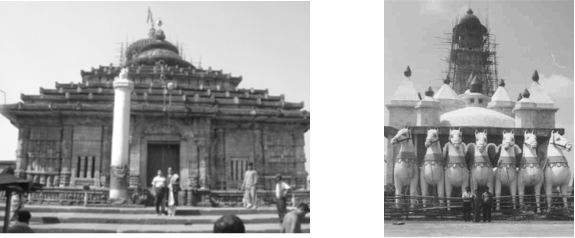
Many small temples, forts and palaces were built in this period i.e. the Lingaraja temple of Bhubaneshwara, the sun temple of konark.
The Jagannath temple of puri and the temples of Khajuraho
(v) Amongst the crafts associated with temples, the making of bronze images was the most distinctive. Chola bronze images are considered amongst the finest in the world. While most images were of deities sometimes images were made of devotees as well.
* Agriculture and Irrigation

(i) Many of the achievements of the Cholas were made possible through new developments in agriculture the river Kaveri branches off into several small channels before emptying into the Bay of Bengal. These channels overflow frequently, depositing fertile soil on their banks. Water from the channels also provides the necessary moisture for agriculture, particularly the cultivation of rice.
(ii) Although agriculture had developed earlier in other parts of Tamil Nadu, it was only from the fifth or sixth century that this area was opened up for large-scale cultivation. Forests had to be cleared in some regions; land had to be levelled in other areas. In the delta region embankments had to be built to prevent flooding and canals has to be constructed to carry water to the fields. In many areas two crops were grown in a year.
(iii) In many cases it was necessary to water crops artificially. A variety of methods were used for irrigation. In some areas wells were dug. In other places huge tanks were constructed to collect rainwater. Remember that irrigation works require planning – organising labour and resources, maintaining these works and deciding on how water is to be shared. Most of the new rulers, as well as people living in villages, took an active interest in these activities.
* The Administration of Empire
(i) Settlements of peasants, known as Ur, became prosperous with the spread of irrigation agriculture.
(ii) Groups of such villages formed larger units called Nadu.
(iii) The village council and the Nadu had several administrative functions including dispensing justice and collecting taxes.
(iv) Rich peasants of the Vethala caste exercised considerable control over the affairs of the Nadu under the supervision of the central Chola government.
(v) The Chola kings gave some rich landowners titles like muvendavelan (a velan or peasant serving three kings), araiyar (chief), etc. as mark of respect, and entrusted them with important offices of the state at the centre.
* Types of Land
(i) Chola inscriptions mention several categories of land:
(a) Vellanvagal : Land of non-Brahmana peasant proprietors
(b) Brahmadeya : Land gifted to Brahmanas
(c) Shalabhoga : Land for the maintenance of a school
(d) Devadana, tirunamattukkani : Land gifted to temples
(e) Pallichchhandam : Land donated to Jaina institutions
(ii) We have seen that Brahmanas often received land grants or brahmadeya. As a result, a large number of Brahmana settlements emerged in the Kaveri valley as in other parts of south India.
(iii) Each Brahmadeya was looked after by an assembly or sabha of prominent Brahmana landholders. These assemblies worked very efficiently. Their decisions were recorded in detail in inscriptions, often on the stone walls of temples.
(iv) Associations of traders known as nagarams also occasionally performed administrative functions in towns.
(v) Inscriptions from Uttaramerur in Chingleput district, Tamil Nadu, provide details of the way in which the sabha was organised. The sabha had separate committees to look after irrigation works, gardens, temples, etc.
(vi) Names of those eligible to be members of these committees were written on small tickets of palm leaf and kept in an earthenware pot, from which a young boy was asked to pick the tickets, one by one for each committee
* China under the Tang dynasty
In China, an empire was established under the Tang dynasty, which remained in power for about 300 years (from the seventh to the tenth centuries). Its capital, Xi’an, was one of the largest cities in the world, visited by Turks, Iranians, Indians, Japanese and Koreans.
The Tang Empire was administered by a bureaucracy recruited through an examination, which was open to all who wished to appear for it. This system of selecting officials remained in place, with some changes, till 1911.

 Param Publication
Param Publication
